Sony Group DCRIP55 Digital Video Camera Recorder DCR-IP55 User Manual DCR IP45 IP55
Sony Corporation Digital Video Camera Recorder DCR-IP55 DCR IP45 IP55
manual
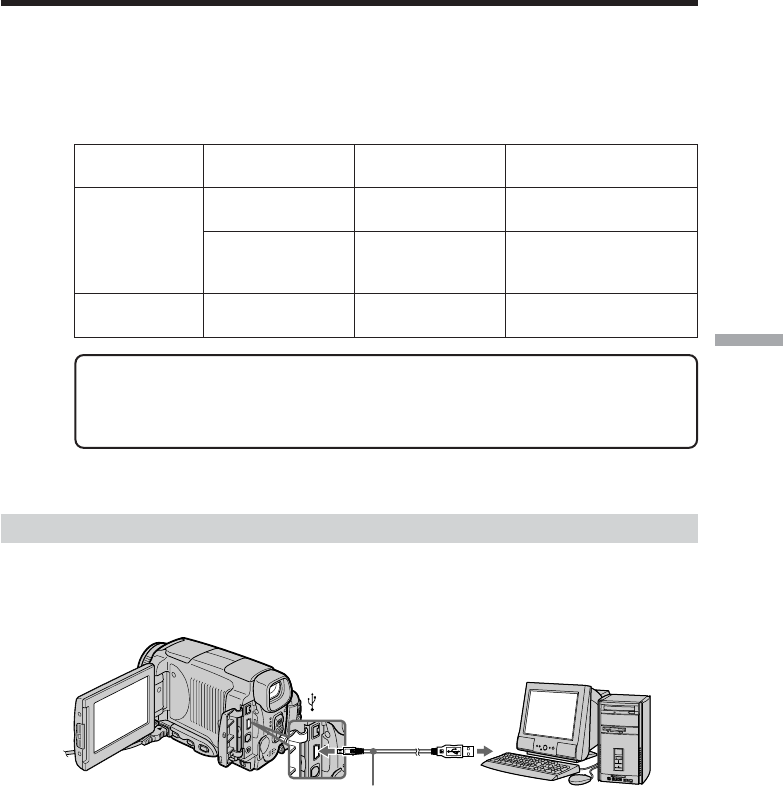
151
Viewing Images Using your Computer
There are the following ways of connecting the camcorder to a computer in order to
view images saved on a “Memory Stick” or recorded on tape on your computer.
To view images on a computer which has a “Memory Stick” slot, first remove the
“Memory Stick” from the camcorder and then insert it into the computer’s “Memory
Stick” slot.
When connecting to a computer via the USB jack, complete installation of the
USB driver before connecting the camcorder to the computer. If you connect
the camcorder to the computer first, you will not be able to install the USB
driver correctly.
For details about your computer’s connecters and editing software, contact the
computer manufacturer.
Viewing images recorded on a tape
When connecting to a computer via the USB jack
For more information, see page xxx.
Camcorder Connection Computer environment
Connection jack cable requirements
USB jack USB cable USB connector,
(supplied) editing software
Tape stills and i. LINK cable i. LINK (IEEE1394)
movies MICROMV jack (DV connecting connector
cable ) (optional) editing software
“Memory Stick” USB jack USB cable USB connector,
stills and movies (supplied) editing software
— Viewing Images Using your Computer —
Viewing images on your computer
– Introduction
(USB) jack
USB connecter
USB cable (supplied)
Push into
the end
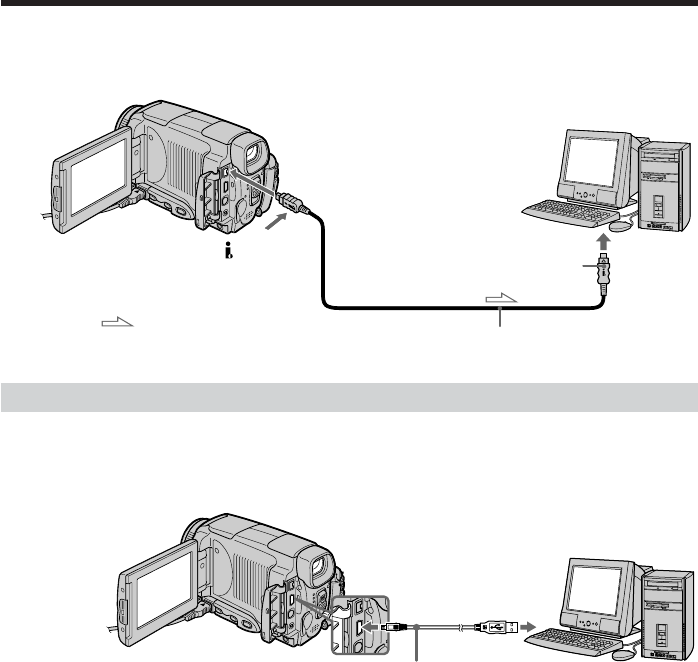
152
When connecting to a computer via the MICROMV jack
Your computer must have a DV connector and editing software installed that can read
video signals.
Viewing images recorded on a “Memory Stick”
When connecting to a computer via the USB jack
See page xxx when using Windows and page xxx when using Macintosh.
You can also use a Memory Stick Reader/Writer (optional).
When connecting to a computer without a USB jack
Use an optional floppy disk adaptor for Memory Sticks or a PC card adaptor for
Memory Sticks.
When purchasing an accessory, check its catalog beforehand for the recommended
operating environment.
Viewing images on your computer – Introduction
: Signal flow
i.LINK cable (optional)
i.LINK
(MICROMV)
is marked
on this side
USB cable (supplied)
(USB) jack

153
Viewing Images Using your Computer
Viewing images on your computer – Introduction
Notes on using your computer
“Memory Stick”
•“Memory Stick” operations on your camcorder cannot be assured if a “Memory Stick”
formatted on your computer is used on your camcorder, or if the “Memory Stick” in
your camcorder was formatted from your computer when the USB cable was
connected.
•Do not compress the data on the “Memory Stick.” Compressed files cannot be played
back on your camcorder.
Software
•Depending on your application software, the file size may increase when you open a
still image file.
•When you load an image modified using retouching software from your computer to
your camcorder or when you directly modify the image on your camcorder, the image
format will differ so a file error indicator may appear and you may be unable to open
the file.
Communications with your computer
Communications between your camcorder and your computer may not recover after
recovering from Suspend, Resume, or Sleep.
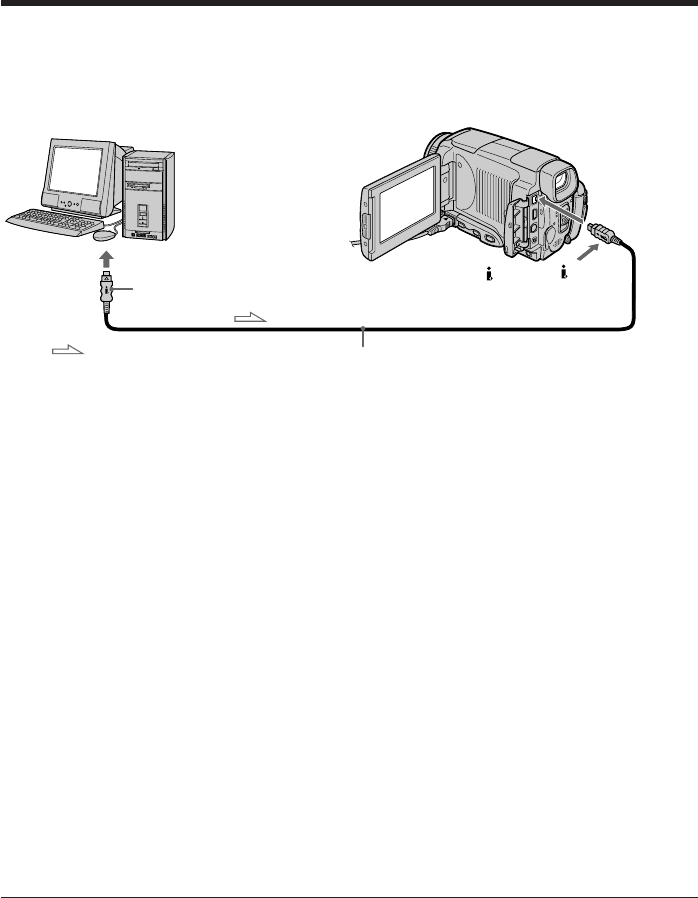
154
You can view or edit the images recorded on a tape using your computer. You can
record images edited with the computer on the tape.
To view images on your computer, the application software MovieShaker Ver. 3.1 for
MICROMV (supplied) is required.
Note
To view images on your computer, you have to install the i.LINK driver and the
application software into your computer. They are included in the supplied application
software MovieShaker Ver. 3.1 for MICROMV.
Before installing the i.LINK driver and the application software into your computer, be
sure not to connect the camcorder to the computer. For details on installing and on an
i.LINK connection, refer to the operating instructions supplied with MovieShaker Ver.
3.1 for MICROMV.
Recommended computer environment
Recommended Windows environment
OS: Microsoft Windows MillennuiumEdition, Windows 2000 Professional,
Windows XP Home/Professional (support to be provided). Standard
installation is required.
Operation is not assured if the above environment is an upgraded OS.
CPU: MMX Pentium III 600 MHz or faster (Required)
MMX Pentium III 800 MHz or faster (Recommended)
Main memory: 128 MB or larger (Required)
256 MB or larger (Recommended)
Display: 800 × 600 or larger screen size/1024 × 480 or larger screen size, 16-bit
color or higher
Hard disk: 100 MB hard disk space (for installation), ATA66 or higher speed
(required for capturing an image)
The i.LINK (IEEE1394) connector must be provided as standard.
Note
Operations are not guaranteed for all the recommended computer environments
mentioned above.
Connecting your camcorder to your
computer using the i.LINK jack
i.LINK connector
Computer
i.LINK cable
i.LINK
(MICROMV)
: Signal flow

155
Viewing Images Using your Computer
Connecting your camcorder to your computer
using the USB cable – For Windows users
Complete installation of the USB driver before connecting the camcorder to
the computer. If you connect the camcorder to the computer first, you will not
be able to install the USB driver correctly.
When connecting to a computer via the USB jack
You must install a USB driver onto your computer in order to connect the camcorder to
the computer’s USB connector. The USB driver can be found on the CD-ROM supplied,
along with the application software required for viewing images.
If you connect your camcorder and your computer using the USB cable, you can view
pictures live from your camcorder and pictures recorded on a tape on your computer
(USB streaming function).
Furthermore, if you download pictures from your camcorder to your computer, you can
process or edit them in image processing software and append them to e-mail.
You can view images recorded on a “Memory Stick” on your computer.
Recommended computer usage environment when connecting
via USB cable and viewing tape images on the computer
OS:
Microsoft Windows 98SE, Windows Me, Windows 2000 Professional, Windows XP
Home Edition or Windows XP Professional Standard installation is required.
However, operation is not assured if the above environment is an upgraded OS.
You cannot hear sound if your computer is running Windows 98, but you can read still
images.
CPU:
MMX Pentium 500 MHz or faster (800 MHz or faster recommended)
Application:
DirectX 8.0a or later
Sound system:
16 bit stereo sound card and stereo speakers
Memory:
64 MB or more
Hard disk:
Available memory required for installation:
at least 200MB
Available hard disc memory recommended:
at least 1GB (depending on the size of the image files edited)
Display:
4 MB VRAM video card, Minimum 800 × 600 dot Hi color (16 bit color, 65000 colors),
Direct Draw display driver capability (At 800 × 600 dot or less, 256 colors and less, this
product will not operate correctly.)
Others:
This product is compatible with DirectX technology, so it is necessary to install DirectX.
The USB connector must be provided as standard.
You cannot use this function in the Macintosh environment.

156
Connecting your camcorder to your computer using the USB cable
– For Windows users
Recommended computer usage environment when connecting
via USB cable and viewing “Memory Stick” images on the
computer
Recommended Windows environment
OS:
Microsoft Windows 98, Windows 98SE, Windows Me, Windows 2000 Professional,
Windows XP Home Edition or Windows XP Professional standard installation is
required.
However, operation is not assured if the above environment is an upgraded OS.
CPU:
MMX Pentium 200 MHz or faster
The USB connector must be provided as standard.
Windows Media Player must be installed (to play back moving pictures).
Notes
•Operations are not guaranteed for the Windows environment if you connect two or
more USB equipment to a single computer at the same time, or when using a hub.
•Some equipment may not operate depending on the type of USB equipment that is
used simultaneously.
•Operations are not guaranteed for all the recommended computer environments
mentioned above.
•Windows and Windows Media are trademarks or registered trademarks of Microsoft
Corporation in the United States and/or other countries.
•Pentium is trademark or registered trademark of Intel Corporation.
•All other product names mentioned herein may be the trademarks or registered
trademarks of their respective companies. Furthermore, “TM” and “®” are not
mentioned in each case in this manual.
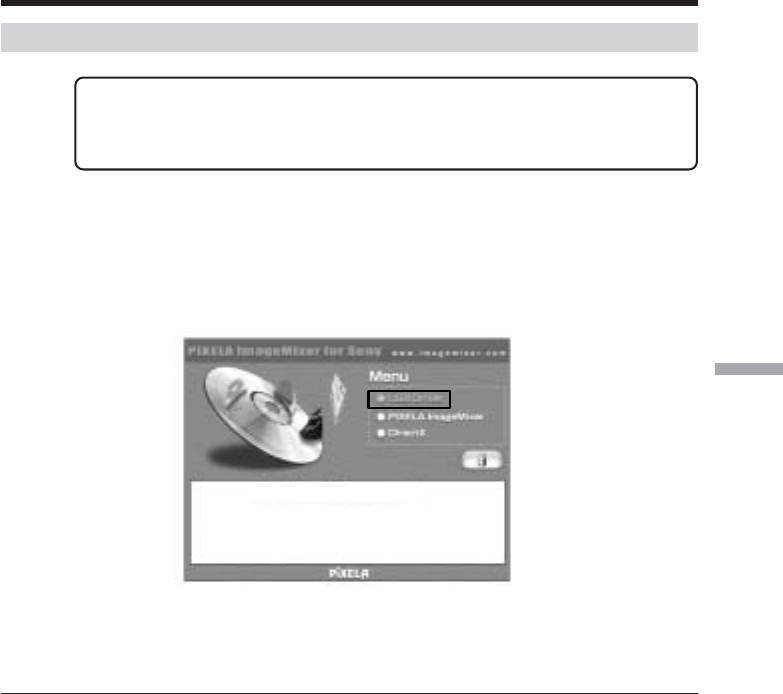
157
Viewing Images Using your Computer
Installing the USB driver
Start the following operation without connecting the USB cable to your
computer.
Connect the USB cable according to “Making the computer recognize the
camcorder”.
If you are using Windows 2000 Professional or Windows XP Home Edition/
Professional, log in with permission of administrators.
(1)Turn on your computer and allow Windows to load.
(2)Insert the supplied CD-ROM in the CD-ROM drive of your computer. The
application software starts up and the title screen appears.
(3)Move the cursor to USB Driver and click. This starts USB driver installation.
(4)Follow the on-screen messages to install the USB driver.
(5)Remove the CD-ROM and then restart the computer, in accordance with the
instructions on the screen.
Note
If you connect the USB cable before USB driver installation is complete, the USB driver
will not be properly registered. Carry out installation again in accordance with the steps
on page xx.
Connecting your camcorder to your computer using the USB cable
– For Windows users
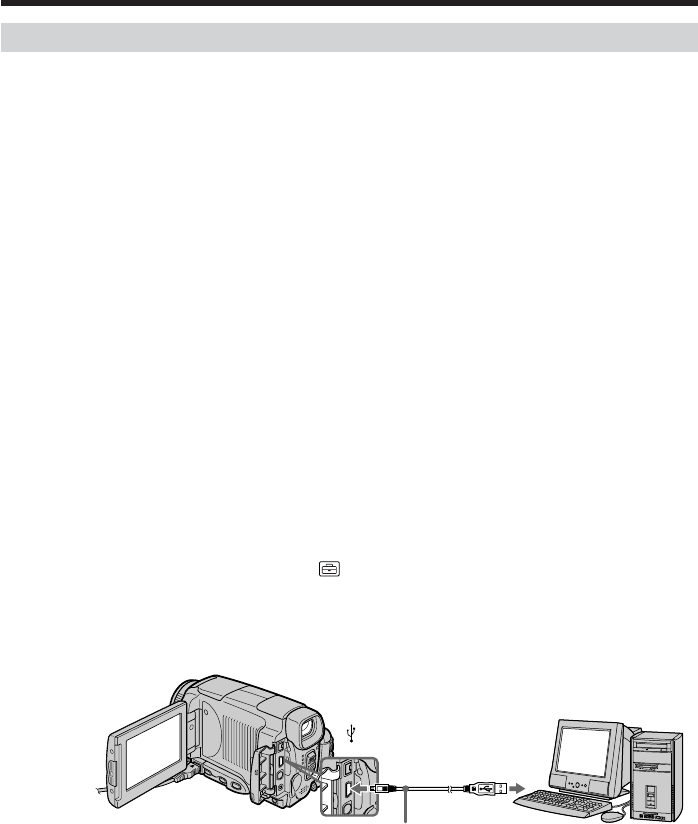
158
Making the computer recognize the camcorder
Viewing images recorded on a tape on your computer
Refer to page 181 for details on viewing “Memory Stick” images on your computer.
You need to install PIXELA ImageMixer to view images recorded on a tape on your
computer. Install it from the CD-ROM supplied with your camcorder.
To install and use this software in Windows 2000 Professional, you must be authorized
as a Power Users or Administrators. For Windows XP, you must be authorized as
Administrators.
(1)Turn on your computer and allow Windows to load.
If you are using your computer, close all running applications.
(2)Insert the supplied CD-ROM into the CD-ROM drive of your computer.
The application software starts up and the title screen appears. If the title screen
does not appear, double-click “My Computer” and then “IMAGEMIXER” (CD-
ROM Drive). The application software screen appears after a while.
(3)Move the cursor to “PIXELA ImageMixer” and click.
The Install Wizard program starts up and the “Select Settings Language” screen
appears.
(4)Select the language for installation.
(5)Follow the on-screen messages.
The installation screen disappears when installation is complete.
(6)Click DirectX.
Follow the on-screen messages to install DirectX.
Restart your computer when the installation is completed.
(7)Connect the AC power adaptor to your camcorder. Set the POWER switch to VCR.
(8)Select USB STREAM to ON in in the menu settings (p. xxx).
(9)With the CD-ROM inserted, connect the USB jacks of the camcorder and computer
using the USB cable supplied with your camcorder.
Your computer recognizes the camcorder, and the Windows Add Hardware
Wizard starts.
(10) Follow the on-screen messages so that the Add Hardware Wizard recognizes that
the USB drivers have been installed. The Add Hardware Wizard starts three times
because three different USB drivers are installed. Be sure to allow the installation
to complete without interrupting it.
For Windows 2000 Professional, Windows XP Home Edition/Professional users
(11)After the “File Needed” screen appears.
Open “Browse...” t “My Computer” t “ImageMixer” t “Sonyhcb.sys”, and
click “OK”.
Connecting your camcorder to your computer using the USB cable
– For Windows users
USB connector
USB cable
(supplied)
(USB) jack
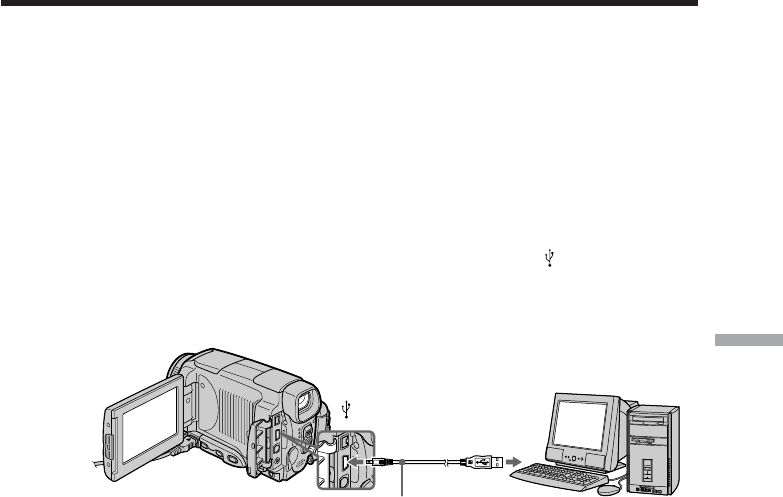
159
Viewing Images Using your Computer
USB connector
USB cable
(supplied)
(USB) jack
Viewing images
Before operation
•You need to install the USB driver to view “Memory Stick” images on your computer.
(p. xx)
An application such as Windows Media Player must be installed to play back moving
pictures in Windows environment.
(1)Turn on your computer and allow Windows to load.
(2)Insert a “Memory Stick” into your camcorder, and connect the AC power adaptor to
your camcorder. Set the POWER switch to MEMORY/NETWORK for DCR-IP55
(MEMORY for DCR-IP45).
(3)When the CD-ROM is inserted on your computer, connect the (USB) jack on your
camcorder to the USB connector on your computer using the supplied USB cable.
USB MODE appears on the LCD screen of your camcorder.
(4)Open “My Computer” on Windows and double-click the newly recognized drive
(Example: “Removable Disk (E:)”).
The folders inside the “Memory Stick” are displayed.
Viewing images recorded on a “Memory
Stick” on your computer
– For Windows users

160
Folder containing moving picture data
Folder containing still image data
Viewing images recorded on a “Memory Stick” on your computer
– For Windows users
(5)Select and double-click the desired image file from the folder.
For the detailed folder and file name, see “Image file storage destinations and image
files” (p. xx).
Desired file type Double-click in this order
Still image “Dcim” folder t“100msdcf” folder tImage file
Moving picture* “Mssony” folder t“Moml0001” folder tImage file*
*Copying a file to the hard disk of your computer before viewing it is recommended. If
you play back the file directly from the “Memory Stick,” the image and sound may
break off.
Image file storage destinations and image files
Image files recorded with your camcorder are grouped in folders by recording mode.
The meanings of the file names are as follows. ssss stands for any number within
the range from 0001 to 9999.
For Windows Me users
(The drive recognizing your camcorder is [E:].)
Folder File Meaning
100MSDCF DSC0ssss.JPG Still image file
MOML0001 MOV0ssss.MPG Moving picture file

161
Viewing Images Using your Computer
Disconnect the USB cable and remove the “Memory Stick” or set
the POWER switch to OFF(CHG).
– For Windows 2000 Professional/Me, Windows XP Home Edition/Professional
users
To unplug the USB cable, eject the “Memory Stick” or set the POWER switch to
OFF(CHG), follow the procedure below.
(1)Move the cursor to the “Unplug or Eject Hardware” icon on the Task Tray and click
to cancel the applicable drive.
(2)After the “Safe to remove” message appears, disconnect the USB cable and remove
the “Memory Stick” or set the POWER switch to OFF(CHG).
Viewing images recorded on a “Memory Stick” on your computer
– For Windows users

162
Connecting your camcorder to your
computer using the USB cable
– For Macintosh users
When connecting to a computer via the USB jack
You must install a USB driver on to your computer in order to connect the camcorder
to the computer's USB connector. The USB driver can be found on the CD-ROM
supplied, along with the application software required for viewing images.
Recommended Macintosh environment
Mac OS 8.5.1/8.6/9.0/9.1/9.2 or Mac OS X (v10.0/v10.1) standard installation is
required.
However, note that the update to Mac OS 9.0/9.1 should be used for the following
models.
•iMac with the Mac OS 8.6 standard installation and a slot loading type CD-ROM drive
•iBook or Power Mac G4 with the Mac OS 8.6 standard installation
The USB connector must be provided as standard.
QuickTime 3.0 or newer must be installed (to play back moving pictures).
Notes
•Operations are not guaranteed for the Macintosh environment if you connect two or
more USB equipment to a single computer at the same time, or when using a hub.
•Some equipment may not operate depending on the type of USB equipment that is
used simultaneously.
•Operations are not guaranteed for all the recommended computer environments
mentioned above.
•Macintosh and Mac OS, QuickTime are trademarks of Apple Computer Inc.
•All other product names mentioned herein may be the trademarks or registered
trademarks of their respective companies. Furthermore, “TM” and “®” are not
mentioned in each case in this manual.
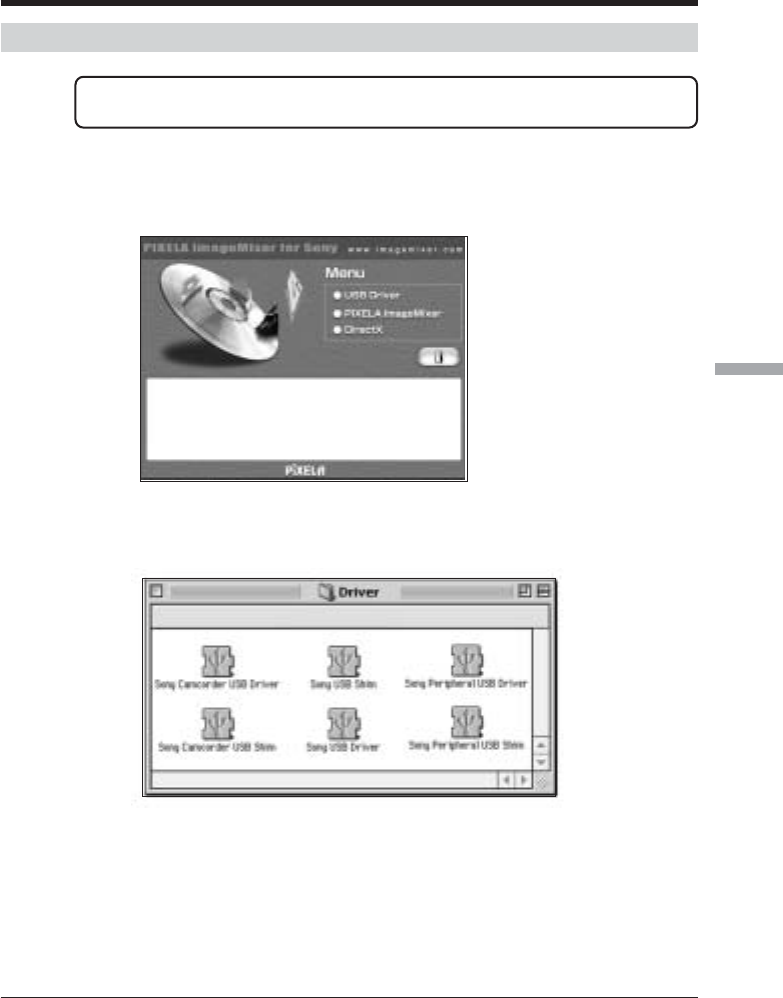
163
Viewing Images Using your Computer
Installing the USB driver
Do not connect the USB cable to your computer before installation of the USB
driver is completed.
For Mac OS 8.5.1/8.6/9.0 users
(1)Turn on your computer and allow the Mac OS to load.
(2)Insert the supplied CD-ROM in the CD-ROM drive of your computer.
The application software screen appears.
(3)Click the “USB Driver” to open the folder containing the six files related to
“Driver.”
(4)Select the following two files, and drag and drop them into the System Folder.
•Sony Camcorder USB Driver
•Sony Camcorder USB Shim
(5)When the message appears, click “OK.”
The USB driver is installed on your computer.
(6)Remove the CD-ROM from the computer.
(7)Restart your computer.
For Mac OS 9.1/9.2/Mac OS X (v10.0)
The USB driver need not be installed. Your Mac is automatically recognized as a drive
just by connecting your Mac using the USB cable.
Connecting your camcorder to your computer using the USB cable
– For Macintosh users

164
Viewing images
Before operation
You need to install the USB driver to view “Memory Stick” images on your computer.
(p. xx)
QuickTime 3.0 or newer must be installed to play back moving pictures.
(1)Turn on your computer and allow Mac OS to load.
(2)Insert a “Memory Stick” into your camcorder, and connect the AC power adaptor to
your camcorder.
(3)Set the POWER switch to MEMORY/NETWORK for DCR-IP55 (MEMORY for
DCR-IP45).
(4)Connect the (USB) jack on your camcorder with the USB connector on your
computer using the supplied USB cable.
(5)Double-click the “Memory Stick” icon on the desktop.
The folders inside the “Memory Stick” are displayed.
(6)Select and double-click the desired image file from the folder.
Desired file type Double-click in this order
Still image “Dcim” folder t“100msdcf” folder tImage file
Moving picture* “Mssony” folder t“Moml0001” folder tImage file*
*Copying a file to the hard disk of your computer before viewing it is recommended. If
you play back the file directly from the “Memory Stick,” the image and sound may
break off.
Disconnect the USB cable and remove the “Memory Stick” or set
the POWER switch to OFF(CHG)
Follow the procedure below.
(1)Close all running applications.
Make sure that the access lamp of the hard disk is not lit.
(2)Drag the “Memory Stick” icon into the “Trash”. Alternatively, select the “Memory
Stick” icon by clicking on it, and then select “Eject disk” from the “Special” menu at
the top left of the screen.
(3)Disconnect the USB cable and remove the “Memory Stick” or the POWER switch to
OFF (CHG).
For Mac OS X (v10.0) users
Shut down your computer, then disconnect the USB cable and remove the “Memory
Stick” or the POWER switch to OFF (CHG).
Connecting your camcorder to your computer using the USB cable
– For Macintosh users
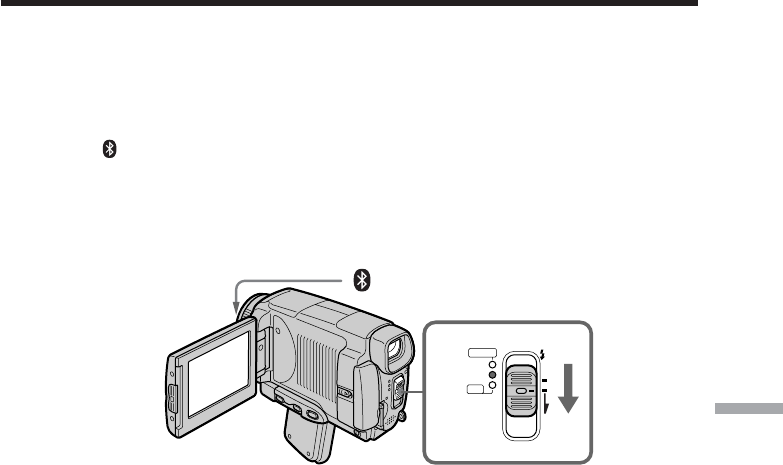
Using the Network function
165
You can access the Internet using a Bluetooth equipped device that is complied to the
camcorder. Once the access is made, you can view a Web page, send/receive your e-
mail, etc. This section describes only how to open the Network Menu.
(1)Set the POWER switch to MEMORY/NETWORK.
(2)Press [NETWORK].
(Bluetooth) lamp lights up and Network Menu appears.
For the details, refer to the Network Function Operating Instructions supplied with
your camcorder.
— Using the Network function —
Accessing the network (DCR-IP55 only)
1
MEMORY
NET
WORK
VCR
CAMERA
(CHG)
POWER
OFF
ON
MODE
(Bluetooth) lamp
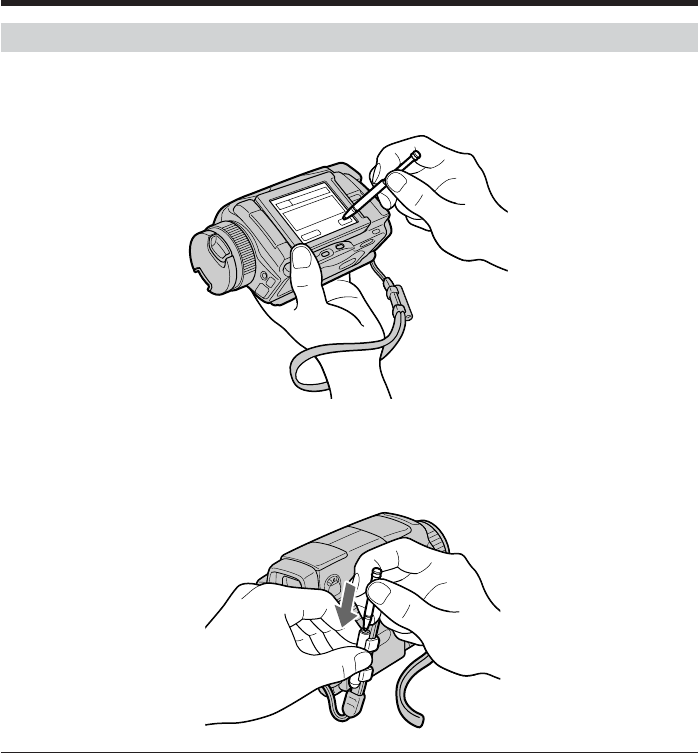
166
Accessing the network
How to hold your camcorder when operating in NETWORK mode
Hold your camcorder with your hand through the wrist strap to keep from dropping it.
The operation buttons needed in NETWORK mode are displayed on the LCD screen.
Press the buttons with the stylus supplied.
After using the stylus
Put it back in the holder on the wrist strap. Hold the stylus correctly as shown in the
illustration and insert it until it clicks.
On trademarks
•The Bluetooth trademarks are owned by their proprietor and used by Sony
Corporation under license.
•All other product names mentioned herein may be the trademarks or registered
trademarks of their respective companies. Furthermore, “TM” and “®” are not
mentioned in each case in this manual.
Note
Make sure that your camcorder is in the standby with the POWER switch set to
MEMORY/NETWORK.
During using the network function
You cannot use the optional printer.
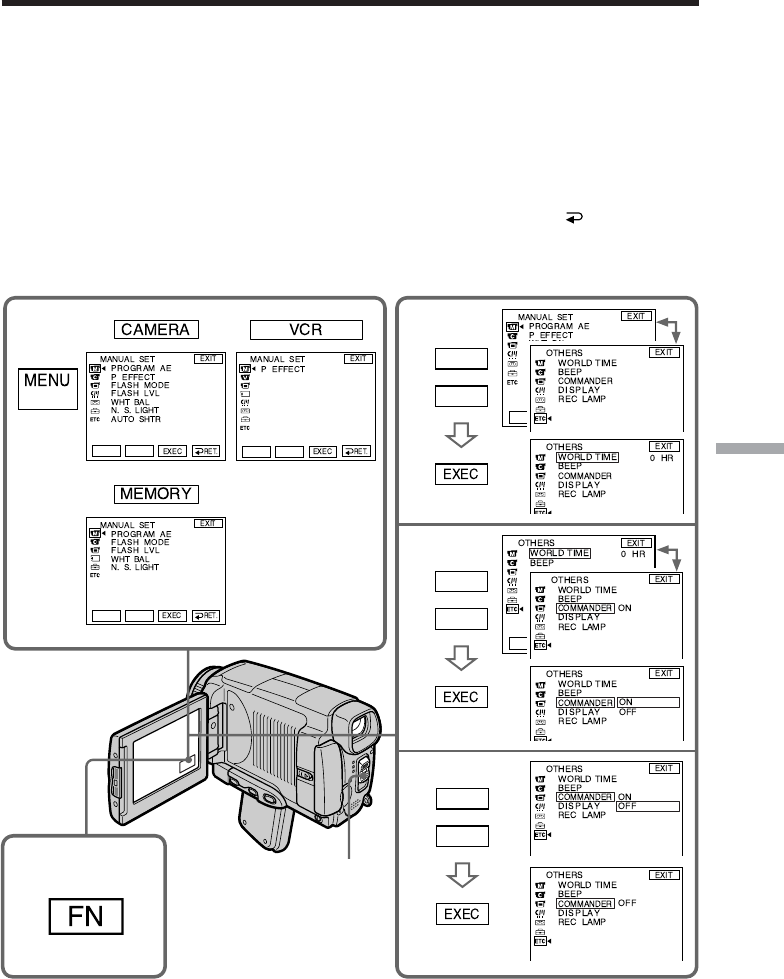
167
Customising Your Camcorder
21
34
5
6
Rr Rr
Rr
Rr
Rr
r
R
r
R
r
R
— Customising Your Camcorder —
Changing the menu settings
To change the mode settings in the menu settings, select the menu items with r/R . The
default settings can be partially changed. First, select the icon, then the menu item and
the mode.
(1)Set the POWER switch to CAMERA, VCR or MEMORY/NETWORK for DCR-IP55
(MEMORY for DCR-IP45).
(2)Press FN to display PAGE1.
(3)Press MENU to display the menu.
(4)Press r/R to select a desired icon, and press EXEC.
(5)Press r/R to select a desired item, and press EXEC.
(6)Press r/R to select a desired setting.
(7)Repeat steps from 4 to 6 if you want to change other items. Press RET. to return
to step 4.
For details, see “Selecting the mode setting of each item” (p. xxx).
To return to FN
Press EXIT.
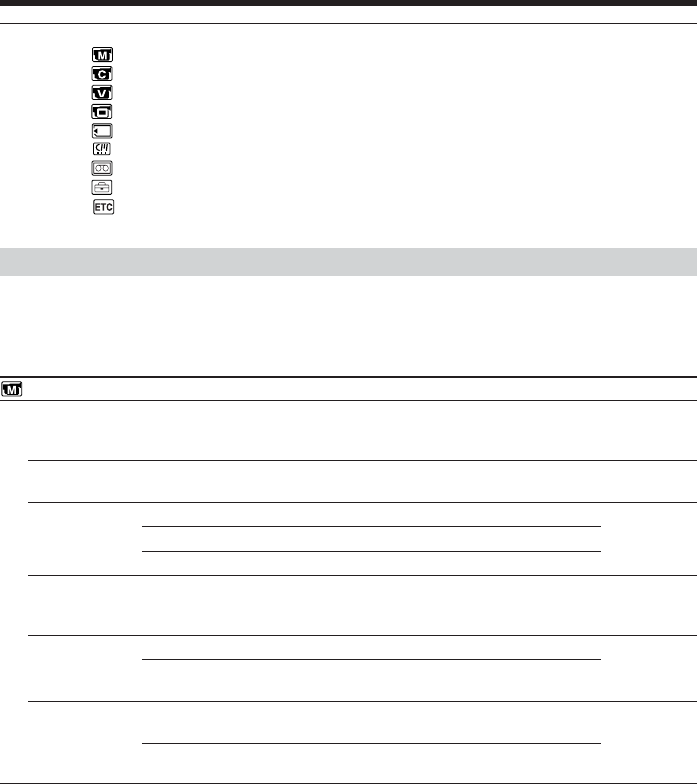
168
Changing the menu settings
Icon/item
MANUAL SET
PROGRAM AE
P EFFECT
FLASH LVL*
WHT BAL
N.S. LIGHT
AUTO SHTR
Mode
——
——
zNORMAL
HIGH
LOW
——
zON
OFF
zON
OFF
Meaning
To suit your specific shooting requirement.
To add special effects like those in films or on the TV
to images (p. xx, xx).
To use the normal setting.
To make the flash level higher than normal.
To make the flash level lower than normal.
To adjust the white balance (p. xx).
To use the NightShot Light function (p. xx).
To cancel the NightShot Light function.
To automatically activate the electronic shutter when
shooting in bright conditions.
To not automatically activate the electronic shutter
even when shooting in bright conditions.
POWER
switch
CAMERA
MEMORY/
NETWORK*
CAMERA
VCR
CAMERA
MEMORY/
NETWORK*
CAMERA
MEMORY/
NETWORK*
CAMERA
MEMORY/
NETWORK*
CAMERA
*For DCR-IP55, set the POWER switch to MEMORY/NETWORK. For DCR-IP45, set
the POWER switch to MEMORY.
Note on FLASH LVL
You cannot adjust FLASH LVL if the external flash (optional) is not compatible with the
flash level.
Menu items are displayed as the following icons:
MANUAL SET
CAMERA SET
VCR SET
LCD/VF SET
MEMORY SET
CM SET
TAPE SET
SETUP MENU
OTHERS
Selecting the mode setting of each item z is the default setting.
Menu items differ depending on the position of the POWER switch.
The LCD screen shows only the items you can operate at the moment.

169
Customising Your Camcorder
*For DCR-IP55, set the POWER switch to MEMORY/NETWORK. For DCR-IP45, set
the POWER switch to MEMORY.
Notes on the SteadyShot function
•The SteadyShot function may not correct excessive camera-shake. Even if STEADY
SHOT is set to ON.
•Attachment of a conversion lens (optional) may influence the SteadyShot function.
If you cancel the SteadyShot function
The SteadyShot off indicator appears. Your camcorder prevents excessive
compensation for camera-shake.
Icon/item
CAMERA SET
D ZOOM
16:9WIDE
STEADYSHOT
HOLOGRAM AF
VCR SET
VIDEOINPUT
Mode
zOFF
20×
120×
zOFF
ON
zON
OFF
zAUTO
OFF
zVIDEO
S VIDEO
Meaning
To deactivate the digital zoom. Up to 10× zoom is
carried out.
To activate the digital zoom. More than 10× to 20×
zoom is performed digitally (p. xx).
To activate the digital zoom. More than 10× to 120×
zoom is performed digitally (p. xx).
Not to record a 16:9 wide picture (p. xx).
To record a 16:9 wide picture.
To compensate for camera-shake.
To cancel the SteadyShot function. Natural pictures
are produced when shooting a stationary subject
with a tripod.
The HOLOGRAM AF emits when focusing on
subjects is difficult in dark places (p. xx)
The HOLOGRAM AF does not emit.
To use the video plug of the A/V connecting cable
when recording from a player.
To use the S video plug of the A/V connecting cable
when recording from a player.
POWER
switch
CAMERA
CAMERA
CAMERA
MEMORY/
NETWORK*
VCR
Changing the menu settings
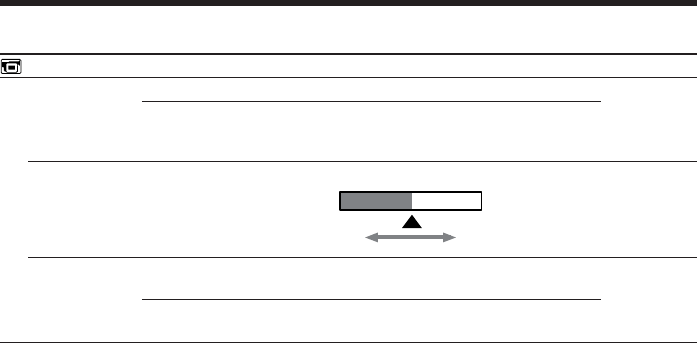
170
Icon/item
LCD/VF SET
LCD B.L.
LCD COLOR
VF B.L.
Mode
zBRT NORMAL
BRIGHT
——
zBRT NORMAL
BRIGHT
Meaning
To set the brightness on the LCD screen normal.
To brighten the LCD screen.
To adjust the color on the LCD screen with –/+.
To set the brightness on the viewfinder screen to
normal.
To brighten the viewfinder screen.
POWER
switch
CAMERA
MEMORY/
NETWORK*
VCR
CAMERA
MEMORY/
NETWORK*
VCR
CAMERA
MEMORY/
NETWORK*
VCR
Changing the menu settings
*For DCR-IP55, set the POWER switch to MEMORY/NETWORK. For DCR-IP45, set
the POWER switch to MEMORY.
Note on NTSC PB
When you play back a tape on a Multi System TV, select the best mode while viewing
the picture on the TV.
Note on LCD B.L. and VF B.L.
When you select BRIGHT, battery life is reduced by about 10 percent during recording.
When you use the power source other than battery pack
LCD B.L. and VF B.L. are automatically selected to BRIGHT.
Even if you adjust LCD B.L., LCD COLOR and/or VF B.L.
The recorded picture will not be affected.
Low intensity high intensity

171
Customising Your Camcorder
Changing the menu settings
Icon/item
MEMORY SET
STILL SET
BURST
QUALITY
IMAGESIZE
MOVIE SET
MOVIEMODE
REMAIN
Mode
zOFF
NORMAL
EXP BRKTG
MULTI SCRN
zSUPER FINE
FINE
STANDARD
z1152 × 864
640 × 480
zSUPER FINE
FINE
STANDARD
LIGHTMODE
zAUTO
ON
Meaning
Not to record continuously.
To record from four to 13 images continuously
(p. xx).
To record three images contimuously with
different exposure.
To record nine images continuously (p. xx).
To record still images in the finest image quality
mode (p. xx).
To record still images in the fine image quality
mode.
To record still images in the standard image
quality mode.
To record still images at 1152 × 864 size
(p. xx).
To record still images at 640 × 480 size.
To record moving pictures with super fine image
quality.
To record moving pictures with fine image
quality.
To record moving pictures with standard image
quality.
To record moving pictures to be used as an e-
mail attachment.
To display the remaining capacity of the
“Memory Stick” in the following cases:
•for five seconds after inserting a “Memory
Stick” into your camcorder.
•when the capacity of the “Memory Stick” is
less than one minute after the POWER switch
is set to MEMORY/NETWORK.
•for five seconds after completing recording.
To always display the remaining capacity of the
“Memory Stick”.
POWER
switch
MEMORY/
NETWORK*
MEMORY/
NETWORK*
VCR
MEMORY/
NETWORK*
MEMORY/
NETWORK*
VCR
MEMORY/
NETWORK*
VCR
*For DCR-IP55, set the POWER switch to MEMORY/NETWORK. For DCR-IP45, set
the POWER switch to MEMORY.
If you select QUALITY
The number of images you can shoot in the currently selected image quality appears on
the screen.
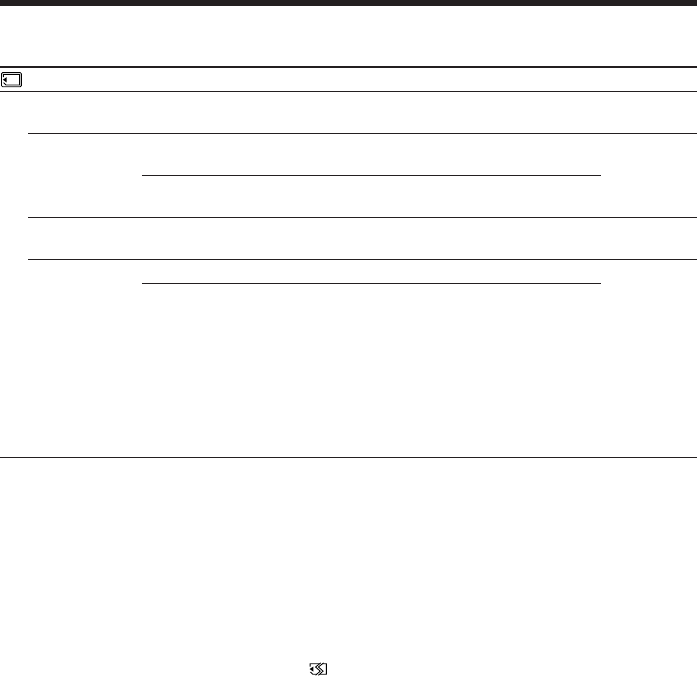
172
Changing the menu settings
Icon/item
MEMORY SET
SLIDE SHOW
FILE NO.
DELETE ALL
FORMAT
Mode
——
zSERIES
RESET
——
zRETURN
OK
Meaning
To play back images in a continuous loop (p. xx).
To assign numbers to file in sequence even if the
“Memory Stick” is changed.
To reset the file numbering each time the
“Memory Stick” is changed.
To delete all the unprotected images (p. xx).
To cancel formatting.
To format an inserted “Memory Stick.”
Formatting erases all information on the
“Memory Stick”.
1. Press r/R to select FORMAT then press EXEC.
2. Press r/R to select OK, then press EXEC.
3. After “EXECUTE” appears, press EXEC.
“FORMATTING” flashes during formatting.
“COMPLETE” appears when formatting is
finished.
POWER
switch
MEMORY/
NETWORK*
MEMORY/
NETWORK*
VCR
MEMORY/
NETWORK*
MEMORY/
NETWORK*
*For DCR-IP55, set the POWER switch to MEMORY/NETWORK. For DCR-IP45, set
the POWER switch to MEMORY.
Notes on formatting
•The “Memory Stick” supplied with your camcorder has been formatted at factory.
Formatting with your camcorder is not required.
•Do not turn the POWER switch or press any button while “FORMATTING” is
displayed.
•You cannot format the “Memory Stick” if the write-protect tab on the “Memory Stick”
is set to LOCK.
•Format the “Memory Stick” if “ FORMAT ERROR”appears.
•Formatting erases protected image data on the “Memory Stick”.

173
Customising Your Camcorder
Changing the menu settings
Icon/item
CM SET
TITLEERASE
TITLE DSPL
TAPE TITLE
ERASE ALL
q INFODSPL
TAPE SET
qREMAIN
Mode
——
zON
OFF
——
——
zON
OFF
zAUTO
ON
Meaning
To erase the title you have superimposed (p. xx).
To display the title you have superimposed.
Not to display the title.
To label a cassette (p. xx).
To erase all the data in cassette memory (p. xx).
To display the cassette information of the tape.
This is displayed for five seconds in the
following cases: (p. xx).
•When turning on the power with a cassette
inserted or inserting a cassette.
•When displaying the recorded data, date
search does not work.
To not display the cassette information of the
tape.
To display the remaining tape bar:
•for about eight seconds after your camcorder
is turned on and calculates the remaining
amount of tape.
•for about eight seconds after a cassette is
inserted and your camcorder calculates the
remaining amount of tape.
•for about eight seconds after the playback
button is pressed in VCR mode.
•for about eight seconds after DISPLAY/
TOUCH PANEL is pressed to display the
screen indicators.
To always display the remaining tape indicator.
POWER
switch
CAMERA
VCR
VCR
CAMERA
VCR
CAMERA
VCR
CAMERA
VCR
CAMERA
VCR
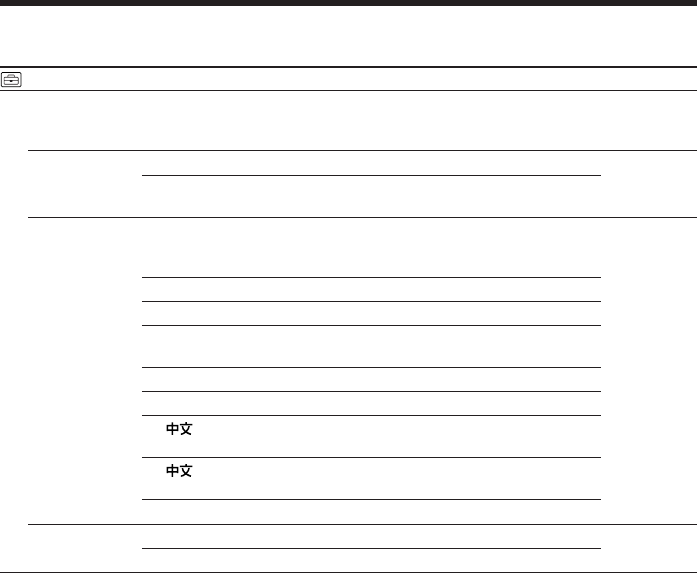
174
Changing the menu settings
Icon/item
SETUP MENU
CLOCK SET
USB STREAM
LANGUAGE
DEMO MODE
Meaning
To set the date or time (p. xx).
To deactivate the USB streaming function.
To activate the USB streaming function.
To display the following information indicators
in English: min, STBY, REC, CAPTURE, VOL,
END SEARCH and START.
To display the information indicators in French.
To display the information indicators in Spanish.
To display the information indicators in.
Portuguese.
To display the information indicators in German.
To display the information indicators in Italian.
To display the information indicators in Chinese
(traditional).
To display the information indicators in Chinese
(simplified).
To display the information indicators in Greek.
To make the demonstration appear.
To cancel the demonstration mode.
POWER
switch
CAMERA
MEMORY/
NETWORK*
CAMERA
VCR
CAMERA
VCR
CAMERA
Mode
——
zOFF
ON
zENGLISH
FRANÇAIS
ESPAÑOL
PORTUGUÊS
DEUTSCH
ITALIANO
[COMP]
[SIMP]
zON
OFF
*For DCR-IP55, set the POWER switch to MEMORY/NETWORK. For DCR-IP45, set
the POWER switch to MEMORY.
Notes on DEMO MODE
•You cannot select DEMO MODE when a cassette is inserted in your camcorder.
•When NIGHTSHOT is set to ON, the “NIGHTSHOT” indicator appears on the screen
and you cannot select DEMO MODE in the menu settings.
•If you press the touch panel during the demonstration, the demonstration stops for a
while, then it starts again after about 10 minutes.
•DEMO MODE is set to STBY (Standby) at the default setting and the demonstration
starts about 10 minutes after you have set the POWER switch to CAMERA without a
cassette inserted.
To cancel the demonstration, insert a cassette, set the POWER switch to other than
CAMERA, or set DEMO MODE to OFF. To set to STBY (Standby) again, leave the
DEMO MODE at ON in the menu settings, turn the POWER switch OFF (CHG), and
return the POWER switch to CAMERA.

175
Customising Your Camcorder
Icon/item
OTHERS
DATA CODE
(On the Remote
Commander)
AREA SET
DST SET
BEEP
COMMANDER
DISPLAY
REC LAMP
Meaning
To display date, time and various settings during
playback. When you press the DATA CODE
button on the Remote Commander.
To display date and time during playback.
To set your area temporarily, when using the
camcorder, in a new location (p. XX).
To be used when your area is not in daylight
saving time.
To be used when your area is in daylight saving
time.
To output the melody when you start/stop
recording or when an unusual condition occurs
on your camcorder.
To output the beep instead of the melody.
To cancel melody and the beep sound.
To activate the Remote Commander supplied
with your camcorder.
To deactivate the Remote Commander to avoid
remote control misoperation caused by other
VCR’s remote control.
To show the display on the LCD screen and
viewfinder.
To show the display on the TV screen, LCD
screen and viewfinder.
To light up the camera recording lamp at the
front of your camcorder.
To turn the camera recording lamp off so that the
subject is not aware of recording.
POWER
switch
MEMORY/
NETWORK*
VCR
CAMERA
MEMORY/
NETWORK*
CAMERA
MEMORY/
NETWORK*
CAMERA
MEMORY/
NETWORK*
VCR
CAMERA
MEMORY/
NETWORK*
VCR
CAMERA
MEMORY/
NETWORK*
VCR
CAMERA
MEMORY/
NETWORK*
Mode
zDATE/CAM
DATE
——
zOFF
ON
zMELODY
NORMAL
OFF
zON
OFF
zLCD
V-OUT/LCD
zON
OFF
Changing the menu settings
*For DCR-IP55, set the POWER switch to MEMORY/NETWORK. For DCR-IP45, set
the POWER switch to MEMORY.
Note
If you press DISPLAY/TOUCH PANEL with DISPLAY set to V-OUT/LCD in the menu
settings, the picture from a TV or VCR will not appear on the LCD screen even when
your camcorder is connected to the output jacks on the TV or VCR.
When recording a close subject
When REC LAMP is set to ON, the red camera recording lamp on the front of the
camcorder may reflect on the subject if it is close. In this case, we recommend you set
REC LAMP to OFF.
In more than five minutes after removing the power source
The PROGRAM AE, FLASH LVL, WHT BAL, HiFi SOUND and COMMANDER items
return to their default settings.
Other menu items are held in memory even when the battery is removed.

176
If you run into any problem using your camcorder, use the following table to
troubleshoot the problem. If the problem persists, disconnect the power source and
contact your Sony dealer. If “C:ss:ss” appears on the screen, the self-diagnosis
display function has activated. See page xxx.
In the recording mode
Symptom Cause and/or Corrective Actions
•The POWER switch is not set to CAMERA.
cSet it to CAMERA (p. xx).
•The tape has run out.
cRewind the tape or insert a new one (p. xx, xx).
•The write-protect tab is set to expose the red mark.
cUse a new cassette or slide the tab (p. xx).
•The tape is stuck to the drum (moisture condensation).
cRemove the cassette and leave your camcorder for at
least
1 hour to acclimatize (p. xx).
•While being operated in CAMERA mode, your camcorder
has been in the standby mode for more than five minutes.
cSet the POWER switch to OFF (CHG) and then to ON
(p. xx).
•The battery pack is dead or nearly dead.
cInstall a fully charged battery pack (p. xx).
•The viewfinder lens is not adjusted correctly.
cAdjust the viewfinder lens (p. xx).
•STEADYSHOT is set to OFF in the menu settings.
cSet it to ON in the menu settings (p. xx).
•The setting is the manual focus mode.
cPress FOCUS to set to the auto focus mode (p. xx).
•Shooting conditions are not suitable for autofocus.
cAdjust to focus manually (p. xxx).
•The LCD panel is open.
cClose the LCD panel (p. xx).
•The contrast between the subject and background is too
high. This is not a malfunction.
•This is not a malfunction.
•Super NightShot or Color Slow Shutter mode is activated.
This is not a malfunction.
START/STOP does not operate.
The power goes off.
— Troubleshooting —
Types of trouble and how to correct trouble
The image on the viewfinder screen
is not clear.
The picture does not appear in the
viewfinder.
The autofocusing function does not
work.
The SteadyShot function does not
work.
A vertical band appears when you
shoot a very bright subject.
Some tiny white spots appear on the
screen.
A vertical band appears when you
shoot a subject such as lights or a
candle flame against a dark
background.

177
Troubleshooting
Types of trouble and how to correct trouble
Symptom Cause and/or Corrective Actions
•If 10 minutes elapse after you set the POWER switch to
CAMERA without a cassette inserted, your camcorder
automatically starts the demonstration.
cInsert a cassette or press the LCD screen. The
demonstration stops. You can also cancel DEMO MODE
(p. xxx) in the menu settings.
•NIGHTSHOT is set to ON.
cSet it to OFF (p. xx).
•NIGHTSHOT is set to ON in a bright place.
cSet it to OFF (p. xx).
•The backlight function is active.
cSet it off (p. xx).
•BEEP is set to OFF in the menu settings.
cSet it to MELODY or NORMAL (p. xxx).
•Set STEADYSHOT to OFF in the menu settings (p. xxx).
•The power of the external flash is off or the power source
is not installed.
cTurn on the external flash or install the power source.
•Two or more external flashes (optional) are attached.
cOnly one external flash (optional) can be attached.
(continued on the following page)
Picture appears too bright, and the
subject does not appear on the
screen.
The picture is recorded in incorrect or
unnatural colors.
The click of the shutter does not
sound.
A black band appears when
recording a TV screen or computer
screen.
An unknown picture is displayed on
the screen.
An external flash (optional) does not
work.
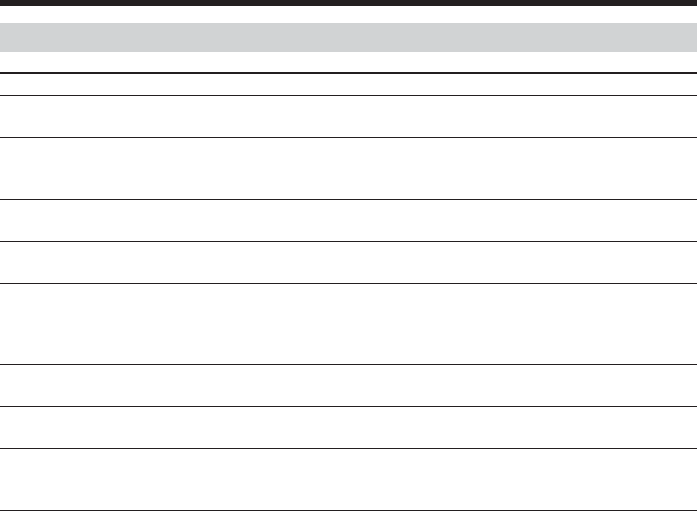
178
In the playback mode
Symptom Cause and/or Corrective Actions
•The tape has run out.
cRewind the tape (p. xx).
•The video head may be dirty.
cClean the head using the cleaning cassette (optional)
(p. xxx).
•Volume is turned to minimum.
cTurn up the volume (p. xx).
•The tape has a blank portion in the beginning of the tape
or between record portion. (p. xxx).
•There is no title in the tape.
cSuperimpose the titles (p. xxx).
•The tape has a blank portion in the beginning of the tape
or between record portion. (p. xxx).
•TITLE DSPL is set to OFF in the menu settings.
cSet it to ON in the menu settings (p. xxx).
•VIDEOINPUT is not set correctly in the menu settings.
cSet it to the appropriate position (p. xx).
•When playing back a transition of recordings, the
playback picture freezes for about one second. This is not a
malfunction.
The title is not displayed.
The multi-picture search, title search
or date search function does not
work.
No sound or only a low sound is
heard when playing back a tape.
There are horizontal lines on the
picture or the playback picture is not
clear or does not appear.
Displaying the recorded data, date
search does not work.
Playback is not possible.
Types of trouble and how to correct trouble
Dubbing cannot be made when using
the A/V connecting cable.
The playback picture freezes for
about one second.

179
Troubleshooting
In the recording and playback modes
Symptom Cause and/or Corrective Actions
•The battery pack is not installed, or is dead or nearly dead.
cInstall a charged battery pack (p. xx, xx).
•The AC power adaptor is not connected to a wall outlet.
cConnect the AC power adaptor to a wall socket (p. xx).
•The temperature of the environment is too low.
•The battery pack is not fully charged.
cCharge the battery pack fully again (p. xx).
•The battery pack is completely dead, and cannot be
recharged.
cReplace with a new battery pack (p. xx).
•You have used the battery pack in an extremely hot or
cold environmment for a long time.
•The battery pack is completely dead, and cannot be
recharged.
cReplace with a new battery pack (p. xx).
•The battery is not fully charged.
cCharge the battery pack fully again (p. xx).
•A deviation has occured in the remaining time.
cCharge the battery pack fully again so that the indication
on the battery remaining indicator is correct (p. xx).
•A deviation has occurred in the remaining battery time.
cCharge the battery pack fully again so that the indication
on the battery remaining indicator is correct (p. xx).
•The power source is disconnected.
cConnect it firmly (p. xx, xx).
•The battery is exhausted.
cUse a charged battery pack (p. xx, xx).
•Moisture condensation has occurred.
cRemove the cassette and leave your camcorder for at
least one hour to acclimatize (p. xxx).
•The q REMAIN is set to AUTO in the menu settings.
cSet it to ON to always display the remaining tape
indicator (p. xxx).
(continued on the following page)
Types of trouble and how to correct trouble
The battery pack is quickly
discharged.
The POWER switch does not turn on.
The % and Z indicators flash and no
functions except for cassette ejection
work.
The cassette cannot be removed from
the holder.
The battery remaining indicator does
not indicate the correct time.
Remaining tape indicator is not
displayed.
The power goes off although the
battery remaining indicator indicates
that the battery pack has enough
power to operate.
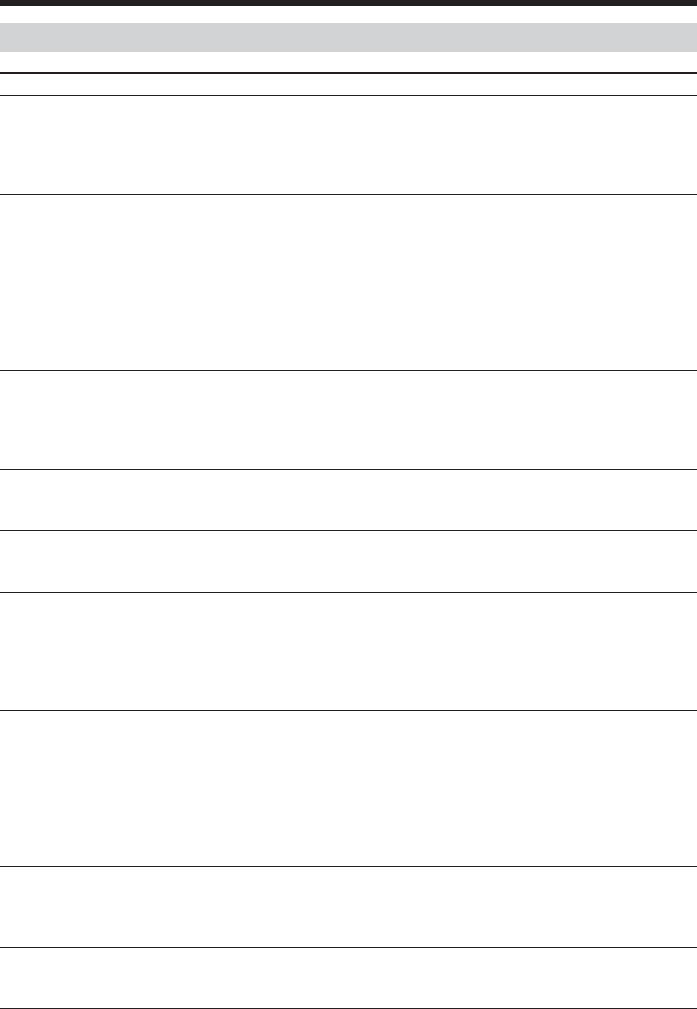
180
Types of trouble and how to correct trouble
When operating using the “Memory Stick”
Symptom Cause and/or Corrective Actions
•The POWER switch is not set to MEMORY/NETWORK
for DCR-IP55 (MEMORY for DCR-IP45).
cSet it to MEMORY/NETWORK or MEMORY (p. xxx).
•The “Memory Stick” is not inserted.
cInsert a “Memory Stick” (p. xxx).
•The “Memory Stick” has already been recorded to its full
capacity.
cDelete unnecessary images and record again (p. xx).
•The “Memory Stick” formatted incorrectly is inserted.
cFormat the “Memory Stick” using your camcorder or
use another “Memory Stick” (p. xxx).
•The write-protect tab on the “Memory Stick” is set to
LOCK.
cRelease the lock (p. xxx).
•The image is protected.
cCancel image protection (p. xxx).
•The write-protect tab on the “Memory Stick” is set to
LOCK.
cRelease the lock (p. xxx).
•The write-protect tab on the “Memory Stick” is set to
LOCK.
cRelease the lock (p. xx).
•The write-protect tab on the “Memory Stick” is set to
LOCK.
cRelease the lock (p. xxx).
•The write-protect tab on the “Memory Stick” is set to
LOCK.
cRelease the lock (p. xxx).
•The INDEX screen is not displayed.
cPress INDEX to display the index screen then protect the
image (p. xxx).
•The write-protect tab on the “Memory Stick” is set to
LOCK.
cRelease the lock (p. xxx).
•The INDEX screen is not displayed.
cThe print marks cannot be written to the single screen
(p. xxx).
•You are trying to write a print mark on a moving picture.
cPrint marks cannot be written to moving picture.
•You may not be able to play back images in actual size
when you try to play back images recorded by other
equipment.
This is not a malfunction.
•Your camcorder cannot play back some images processed
with a computer (The file name flashes on the LCD
screen).
Recording does not function.
The image cannot be deleted.
You cannot format the “Memory
Stick.”
You cannot write a print mark on the
still image.
You cannot protect the image.
Deleting all the images cannot be
carried out.
The “Memory Stick” does not
function.
You cannot play back images in
actual size.
You cannot play back image data.

181
Troubleshooting
Others
Symptom Cause and/or Corrective Actions
•20 titles have been recorded.
cErase unnecessary title (p. xxx).
•The cassette is set to prevent accidental erasure.
cSlide the write-protect tab so that red portion is not
visible (p. xx).
•The tape has a blank portion in the recorded portion.
cSuperimpose the title to the recorded position (p. xxx).
•The tape is set to prevent accidental erasure.
cSlide the write-protect tab so that red portion is not
visible (p. xx).
•COMMANDER is set to OFF in the menu settings.
cSet it to ON (p. xxx).
•Something is blocking the infrared rays.
cRemove the obstacle.
•The batteries are inserted in the battery holder with the + –
polarities incorrectly matching the + – marks.
cInsert the batteries with the correct polarity (p. xxx).
•The batteries are dead.
cInsert new ones (p. xxx).
•DISPLAY is set to V-OUT/LCD in the menu settings.
cSet it to LCD (p. xxx).
•Moisture condensation has occurred.
cRemove the cassette and leave your camcorder for at
least one hour to acclimatize (p. xxx).
•Some troubles have occurred in your camcorder.
cRemove the cassette and insert it again, then operate
your camcorder.
•The POWER switch is not set to OFF (CHG).
cSet it to OFF (CHG) (p.xx).
•The battery pack is not properly installed.
cInstall it properly (p.xx).
•Something is wrong with the battery pack.
cPlease contact your Sony dealer or local authorized Sony
service facility.
•Disconnect the AC power adaptor from a wall outlet or
remove the battery, then reconnect it in about one minute.
Turn the power on. If the functions still do not work, press
the reset button using a sharp-pointed object. (If you press
the reset button, all the settings (DCR-IP55: except the
NETWORK mode settings) including the date and time
return to the default) (p. xxx).
(continued on the following page)
The Remote Commander supplied
with your camcorder does not work.
Types of trouble and how to correct trouble
A cassette label is not recorded.
The picture from a TV or VCR does
not appear even when your
camcorder is connected to the
outputs on the TV or VCR.
A title is not recorded.
No function works though the power
is on.
The melody or beep sounds for
five seconds.
You cannot charge the battery pack.
While charging the battery pack, no
indicator appears, or the indicator
flashes on the LCD screen.
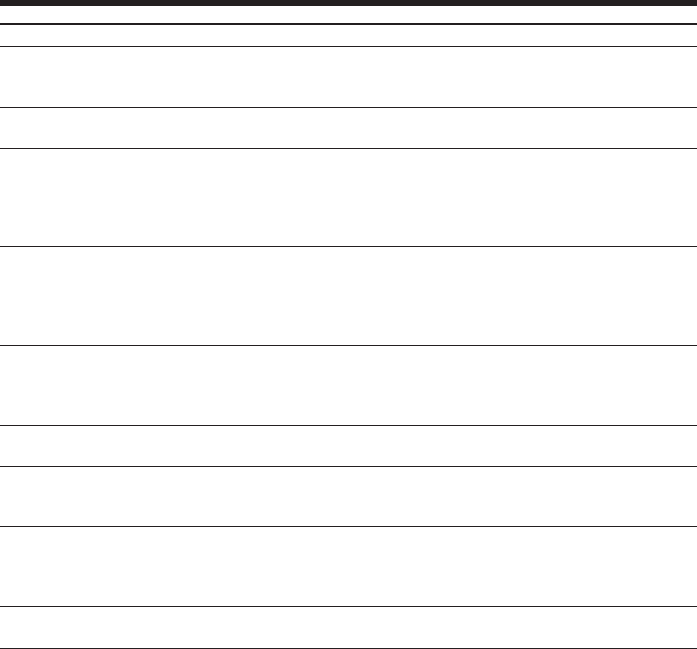
182
Types of trouble and how to correct trouble
Symptom Cause and/or Corrective Actions
•Charging is completed.
•The battery pack is not properly installed.
cInstall it properly (p. xx).
•The POWER switch is not set to OFF (CHG).
cSet it to OFF (CHG).
•The battery pack is not properly installed.
cInstall it properly (P. xx).
•Something is wrong with the battery pack.
cPlease contact your Sony dealer or local authorized Sony
service facility.
•This is because some functions use a linear mechanism.
Your camcorder is not malfunctioning.
•The DISPLAY/TOUCH PANEL button is pressed.
cPress the LCD screen lightly.
cPress DISPLAY/TOUCH PANEL on your camcorder or
DISPLAY on the Remote Commander (p. xx).
cAdjust the screen (CALIBRATION) (p. xxx).
•The mirror mode is activated.
This is not a malfunction.
•The USB cable was connected before installation of the
USB driver was completed.
cUninstall the incorrect USB driver and re-install the
USB driver (p. xxx).
•Moisture condensation has started to condense in your
camcorder (p. xxx).
The buttons do not appear on the
touch panel.
The buttons on the LCD screen do
not work.
The indicators appear mirror-
reversed in the viewfinder.
While charging the battery pack, the
CHG lamp flashes.
You cannot charge the battery pack.
While charging the battery pack, the
CHG lamp does not light up.
Image data cannot be transferred by
the USB connection.
A cassette cannot be removed even if
the cassette lid is open.
When you set the POWER switch to
VCR or OFF (CHG), if you move
your camcorder, you may hear a
clattering sound from inside your
camcorder.

183
Troubleshooting
C:21:00
Self-diagnosis display
Five-digit display Cause and/or Corrective Actions
•You are using a battery pack that is not an
“InfoLITHIUM” battery pack.
cUse an “InfoLITHIUM” battery pack.
•Moisture condensation has occurred.
cRemove the cassette and leave your camcorder for at
least 1 hour to acclimatize (p. xxx).
•The video heads are dirty.
cClean the heads using the cleaning cassette (optional)
(p. xxx).
•A malfunction other than the above that you can service
has occurred.
cRemove the cassette and insert it again, then operate
your camcorder.
cDisconnect the mains lead of the AC adaptor or remove
the battery pack. After reconnecting the power source,
operate your camcorder.
•A malfunction that you cannot service has occurred.
cContact your Sony dealer or local authorized Sony
service facility and inform them of the 5-digit code.
(example: E:61:10)
If you are unable to rectify the problem even if you try corrective actions a few times,
contact your Sony dealer or local authorized Sony service facility.
Your camcorder has a self-diagnosis display
function.
This function displays the current condition of
your camcorder as a five-digit code (a combination
of a letter and figures) on the screen. If a five-digit
code is displayed, check the following code chart.
The last two digits (indicated by ss) will differ
depending on the state of your camcorder.
C:21:ss
LCD screen or Viewfinder
Self-diagnosis display
•C:ss:ss
You can service your camcorder
yourself.
•E:ss:ss
Contact your Sony dealer or local
authorized Sony facility.
E:20:ss
E:61:ss
E:62:ss
C:31:ss
C:32:ss
C:04:ss
C:22:ss
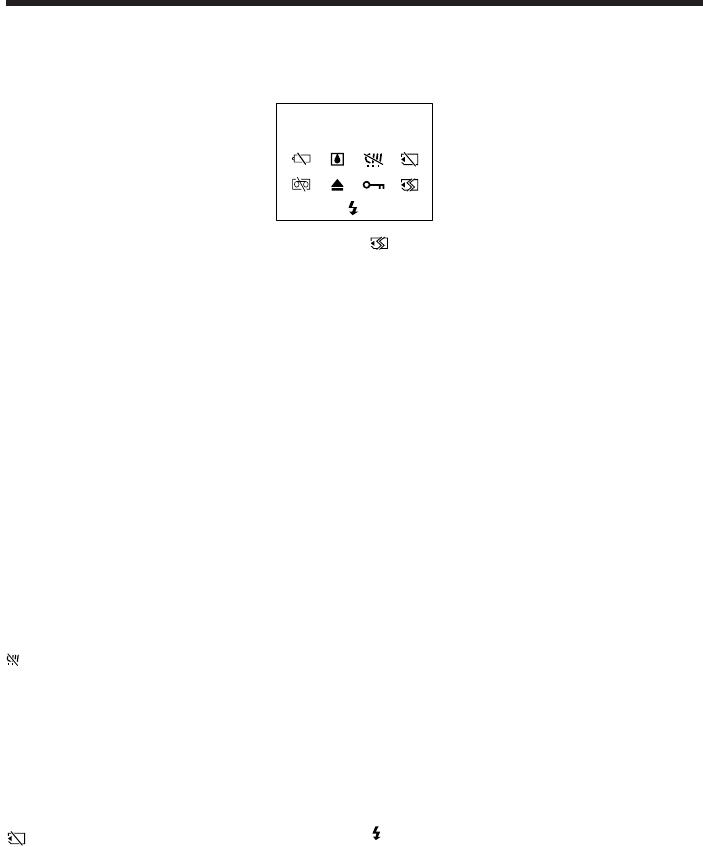
184
Warning indicators and messages
100-0001 Warning indicator as to file
Slow flashing:
•The file is corrupted.
•The file is unreadable.
•You are trying to carry out MEMORY MIX
function on moving picture.
C:21:00 Self-diagnosis display (p. xxx).
EThe battery is dead or nearly dead
Slow flashing:
•The battery is nearly dead.
Depending on operational, enviromental or
battery conditions the E indicator may flash,
even if there are approximately five to 10
minutes remaining.
%Moisture condensation has occurred
Fast flashing:
•Eject the cassette, turn off your camcorder,
and leave it for about one hour with the
cassette compartment open (p. xxx).
Warning indicator as to Micro Cassette
Memory*
Slow flashing:
•Eject the cassette, and insert it again. If even
then the indicator flashes, the Micro Cassette
Memory of the cassette may be faulty.
Fast flashing:
•The Micro Cassette Memory of the
camcorder may be faulty.
Warning indicator as to “Memory Stick”
Slow flashing:
•No “Memory Stick” is inserted.
•The write-protect tab on the “Memory Stick”
is set to LOCK (p. xxx).
Fast flashing:
•The “Memory Stick” is not readable with
your camcorder (p. xxx).
•The image cannot be recorded on “Memory
Stick” (p. xxx, xxx).
If indicators and messages appear on the screen, check the following:
See the page in parentheses “( )” for more information.
Warning indicators
C:21:00100–0001
Warning indicator as to “Memory Stick”
formatting
Fast flashing:
•The “Memory Stick” data is corrupted.
• “Memory Stick” is not formatted correctly (p.
xxx).
QWarning indicator as to tape
Slow flashing:
•The tape is near the end.
•No cassette is inserted.*
•The write-protect tab on the cassette is out
(red) (p. xx).*
Fast flashing:
•The tape has run out.*
ZYou need to eject the cassette
Slow flashing:
•The write-protect tab on the cassette is out
(red) (p. xx).
Fast flashing:
•Moisture condensation has occurred (p. xxx).
•The tape has run out.
•The self-diagnosis display function is
activated (p. xxx).
-The image is protected
Slow flashing:
•The image is protected (p. xxx).
•The write-protect tab on the “Memory Stick”
is set to LOCK (p. xxx).
Warning indicator as to the flash
Slow flashing:
•During charging.
Fast flashing:
•The self-diagnosis display function is
activated (p.XX)
•There is something wrong with the external
flash (optional).
*You hear the melody or beep sound.

185
Troubleshooting
Warning messages
•CLOCK SET Set the date and time (p. xx).
•FOR “InfoLITHIUM” Use an “InfoLIHIUM” battery pack (p. xx).
BATTERY ONLY
• CLEANING CASSETTE2) The video heads are dirty (p. xxx).
•COPY INHIBIT You tried to record a picture that has a copyright
control signal
(p. xxx).1)
• FULL The micro cassette memory is full (p. xxx).1)
• TAPE There is no recorded portion on the tape.1) You
cannot dub new sound (p. xxx).
• “i.LINK” CABLE i.LINK cable is connected (p. xxx).1) You cannot dub
new sound.
• FULL The “Memory Stick” is full (p. xxx).1)
• -The write-protect tab on the “Memory Stick” is set to
LOCK (p.XX).
• NO FILE No image is recorded on the “Memory Stick” (p.
xxx).1)
• NO MEMORY STICK No “Memory Stick” is inserted (p. xxx).1)
• NO STILL IMAGE FILE 1)
• AUDIO ERROR You are trying to record an image with sound that
cannot be recorded by your camcorder on “Memory
Stick” (p. xxx). 1)
• MEMORY STICK ERROR The “Memroy Stick” data is corrupted (p. xxx).1)
• FORMAT ERROR The “Memory Stick” is not recognized (p. xxx).1)
Check the format.
• - DIRECTORY ERROR There is more than two same directories (p. xxx).1)
• PLAY ERROR The image is distorted and cannot be played back.1)
• REC ERROR Check the input signal, then record again.1)
•Q Z TAPE END The tape has reached the end of the tape.1)
•Q NO TAPE Insert a cassette.1)
•DELETING You press PHOTO while deleting data in a “Memory
Stick”.1)
•FORMATTING You press PHOTO while formatting a “Memory
Stick.”1)
• NOW CHARGING Charging an external flash (optional) does not work
correctly.1)
•Q Z CLEANING END The cleaning is complete. Eject the cleaning cassette
(p. xx).
• TITLE FULL 20 titles have been recorded (p. xx).
•INPUT ERROR A picture in an incompatible format (such as one
recorded with the DV format) is input (p. xx).
•NO INPUT You tried to start recording when no signal is input
into the camcorder (p. xx).
Warning indicators and messages

186
Warning indicators and messages
• NOT REC You tried to mix a moving file image (p. xx).
•CHANGE TO “CAM” or “VCR”
A cleaning cassette cannot be used in MEMORY/
NETWORK mode for DCR-IP55 (MEMORY mode for
DCR-IP45) (p. xx).
1) You hear the melody or beep sound.
2) The x indicator and “ CLEANING CASSETTE“ message appear one after another
on the screen.
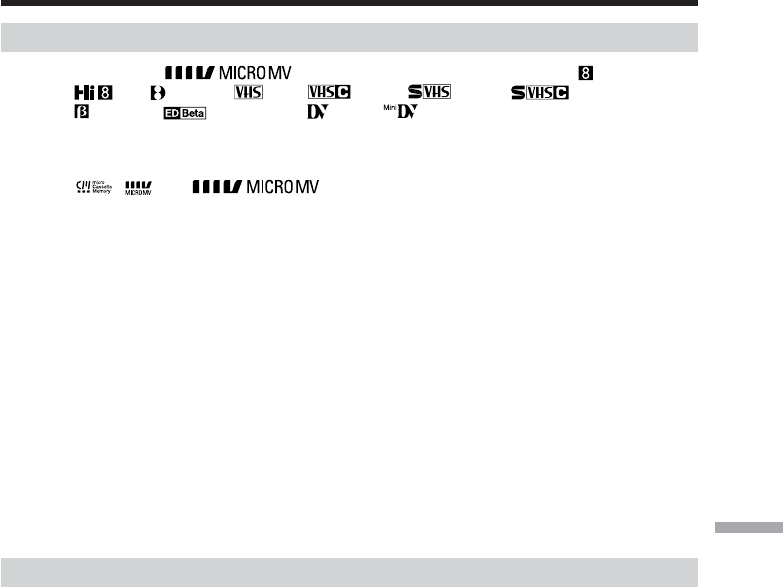
187
Additional Information
— Additional Information —
Usable cassettes
Selecting cassette types
You can use cassette only. You cannot use any other 8 mm,
Hi8, Digital8, VHS, VHSC, S-VHS, S-VHSC,
Betamax, ED Betamax, DV, or mini DV cassettes.
All of the MICROMV cassettes have Micro Cassette Memory.
, , and are trademarks of Sony Corporation.
IC memory is mounted on this type of cassette. Your camcorder can read and write
data such as dates of recording or titles, etc. to this memory.
The functions using the cassette memory require successive signals recorded on the
tape. If the tape has a blank portion at the beginning or between recorded portions,
titles may not be displayed properly or the search functions may not work properly.
Perform the following to prevent a blank portion from being made on the tape.
Press END SCH to go to the end of the recorded portion before you begin the next
recording if you operate the following:
–You have ejected the cassette while recording.
–You have played back the tape.
–You have used the edit search.
If there is a blank portion or discontinuous signal on your tape, re-record from the
beginning to the end of the tape as described above.
The same result may occur when you record using a digital video camera recorder
without a cassette memory on a tape recorded by one with the cassette memory.
Copyright signal
When you play back
If the tape you play back on your camcorder contains copyright signals, you cannot
copy it with another video camera connected to your camcorder.
When you record
You cannot record software on your camcorder that contains copyright control signals
for copyright protection of software.
COPY INHIBIT appears on the LCD screen or on the TV screen if you try to record such
software. Your camcorder does not record copyright control signals on the tape when it
records.
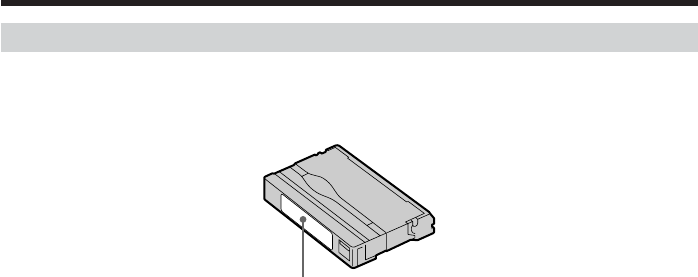
188
Usable cassettes
Notes on the MICROMV cassette
When affixing a label on the MICROMV cassette
Be sure to affix a label only on the location illustrated below [a] so as not to cause
malfunction of your camcorder.
After using the MICROMV cassette
Rewind the tape to the beginning, put the cassette in its case, and store it in an upright
position.
When the Micro Cassette Memory function does not work
Reinsert the cassette.
[a]

189
Additional Information
About the “InfoLITHIUM” battery pack
What is the “InfoLITHIUM” battery pack?
The “InfoLITHIUM” battery pack is a lithium-ion battery pack that has functions for
communicating information related to operating conditions between your camcorder
and an optional AC adaptor/charger.
The “InfoLITHIUM” battery pack calculates the power consumption according to the
operating conditions of your camcorder, and displays the remaining battery time in
minutes.
Charging the battery pack
•Be sure to charge the battery pack before you start using your camcorder.
•We recommend charging the battery pack in an ambient temperature of between 10
°C to 30 °C (50 °F to 86 °F) until the CHG lamp goes off, indicating that the battery
pack is fully charged. If you charge the battery outside of this temperature range, you
may not be able to efficiently charge the battery pack.
•After charging is completed, either disconnect the cable from the DC IN jack on your
camcorder or remove the battery pack.
Effective use of the battery pack
•Battery pack performance decreases in low-temperature surroundings. So, the time
that the battery pack can be used is shorter. We recommend the following to use the
battery pack longer:
–Put the battery pack in a pocket to warm it up, and insert it in your camcorder
immediately before you start taking shots.
–Use the large capacity battery pack (NP-FF70, optional).
•Frequently using the LCD panel or frequently operating playback, fast forward or
rewind wears out the battery pack faster. We recommend using the large capacity
battery pack (NP-FF70, optional).
•Be certain to turn the POWER switch to OFF (CHG) when not taking shots or playing
back on your camcorder. The battery pack is also consumed when your camcorder is
in the standby mode or playback is paused.
•Have spare battery packs handy for two or three times the expected recording time,
and make trial recordings before taking the actual recording.
• Do not expose the battery pack to water. The battery pack is not water resistant.
Remaining battery time indicator
•If the power goes off although the remaining battery time indicator indicates that the
battery pack has enough power to operate, charge the battery pack fully again so that
the indication on the remaining battery time indicator is correct. Note, however, that
the correct battery indication sometimes will not be restored if it is used in high
temperatures for a long time or left in a fully charged state, or the battery pack is
frequently used. Regard the remaining battery time indication as the approximate
shooting time.
•The E mark indicating little remaining battery time sometimes flashes depending on
the operating conditions or ambient temperature and environment even if the
remaining battery time is about five to ten minutes.

190
About the “InfoLITHIUM” battery pack
How to store the battery pack
•If the battery pack is not used for a long time, do the following procedure once per
year to maintain proper function.
1. Fully charge the battery.
2. Discharge on your electronic equipment.
3. Remove the battery from the equipment and store it in a dry, cool place.
•To use the battery pack up on your camcorder, leave your camcorder in the recording
mode until the power goes off without a cassette inserted.
Battery life
•The battery life is limited. Battery capacity drops little by little as you use it more and
more, and as time passes. When the available battery time is shortened considerably, a
probable cause is that the battery pack has reached the end of its life. Please buy a new
battery pack.
•The battery life varies depending on how it is stored and operating conditions and
environment for each battery pack.

191
Additional Information
The i.LINK (MICROMV) jack on this unit is an i.LINK-compliant MICROMV input/
output jack. This section describes the i.LINK standard and its features.
What is i.LINK?
i.LINK is a digital serial interface for handling digital video, digital audio and other
data in two directions between equipment having the i.LINK jack, and for controlling
other equipment.
i.LINK-compatible equipment can be connected by a single i.LINK cable. Possible
applications are operations and data transactions with various digital AV equipment.
When two or more i.LINK-compatible equipment are connected to this unit in a daisy
chain, operations and data transactions are possible with not only the equipment that
this unit is connected to but also with other devices via the directly connected
equipment.
Note, however, that the method of operation sometimes varies according to the
characteristics and specifications of the equipment to be connected, and that operations
and data transactions are sometimes not possible on some connected equipment.
Note
Normally, only one piece of equipment can be connected to this unit by the i.LINK
cable. When connecting this unit to i.LINK-compatible equipment having two or more
i.LINK jacks, refer to the instruction manual of the equipment to be connected.
About the name “i.LINK”
The maximum baud rate of the camcorder is “S400”.
i.LINK is a more familiar term for IEEE 1394 data transport bus proposed by SONY,
and is a trademark approved by many corporations.
IEEE 1394 is an international standard standardized by the Institute of Electrical and
Electronics Engineers.
i.LINK baud rate
i.LINK’s maximum baud rate varies according to the equipment. Three maximum baud
rates are defined:
S100 (approx. 100Mbps*)
S200 (approx. 200Mbps)
S400 (approx. 400Mbps)
The baud rate is listed under “Specifications” in the instruction manual of each
equipment. It is also indicated near the i.LINK jack on some equipment.
The maximum baud rate of equipment, except for this unit, on which it is not indicated
is “S100”.
When units are connected to equipment having a different maximum baud rate, the
baud rate sometimes differs from the indicated baud rate.
*What is Mbps?
Mbps stands for megabits per second, or the amount of data that can be sent or received
in one second. For example, a baud rate of 100Mbps means that 100 megabits of data
can be sent in one second.
About i.LINK

192
About i.LINK
i.LINK functions on this unit
For details on how to dub when this unit is connected to other video equipment having
DV jacks, see page xx.
This unit can also be connected to other i.LINK compatible equipment made by SONY
(e.g. VAIO series personal computer) other than video equipment.
Before connecting this unit to your computer, make sure that application software
supported by this unit is already installed on your computer.
For details on precautions when connecting this unit, also refer to the instruction
manuals for the equipment to be connected.
Required i.LINK Cable
Use the Sony i.LINK 4-pin-to-4-pin cable (during MPEG2 dubbing).
i.LINK and are trademarks.
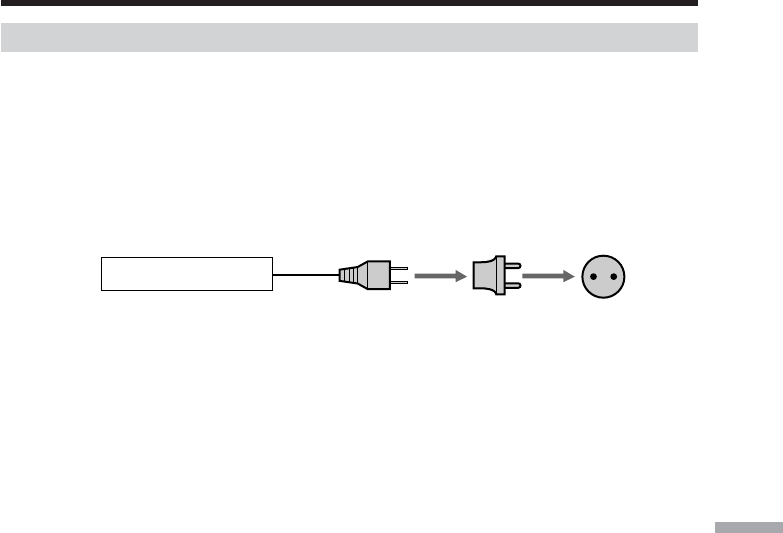
193
Additional Information
Using your camcorder abroad
Countries and areas where you can use network functions are restricted. For details,
refer to the separate network function operating instructions (DCR-IP55 only).
You can use your camcorder in any country or area with the AC adaptor supplied with
your camcorder within 100 V to 240 V AC, 50/60 Hz.
When charging the battery pack, use a commercially available AC plug adaptor [a], if
necessary, depending on the design of the wall outlet [b].
Your camcorder is a NTSC system based camcorder. If you want to view the playback
picture on a TV, it must be a NTSC system based TV with VIDEO/AUDIO input jack.
The following shows TV color systems used overseas.
NTSC system
Bahama Islands, Bolivia, Canada, Central America, Chile, Colombia, Ecuador, Guyana,
Jamaica, Japan, Korea, Mexico, Peru, Surinam, Taiwan, the Philippines, the U.S.A.,
Venezuela, etc.
PAL system
Australia, Austria, Belgium, China, Czech Republic, Denmark, Finland, Germany,
Holland, Hong Kong, Hungary, Italy, Kuwait, Malaysia, New Zealand, Norway,
Poland, Portugal, Singapore, Slovak Republic, Spain, Sweden, Switzerland, Thailand,
United Kingdom, etc.
PAL-M system
Brazil
PAL-N system
Argentina, Paraguay, Uruguay
SECAM system
Bulgaria, France, Guiana, Iran, Iraq, Monaco, Russia, Ukraine, etc.
Using your camcorder abroad
AC-L20A
[b][a]

194
Maintenance information and precautions
Moisture condensation
If your camcorder is brought directly from a cold place to a warm place, moisture may
condense inside your camcorder, on the surface of the tape, or on the lens. In this
condition, the tape may stick to the head drum and be damaged or your camcorder may
not operate correctly. If there is moisture inside your camcorder, the beep sounds and
the % indicator flashes. When the
Z indicator flashes at the same time, the cassette is inserted in your camcorder. If
moisture condenses on the lens, the indicator will not appear.
If moisture condensation occurred
None of the functions except cassette ejection will work. Eject the cassette, turn off your
camcorder, and leave it for about one hour with the cassette compartment open. Your
camcorder can be used again if the % indicator does not appear when the power is
turned on again.
If moisture starts to condense, your camcorder sometimes cannot detect condensation.
If this happens, the cassette is sometimes not ejected for ten seconds after the cassette
lid is opened. This is not a malfunction. Do not close the cassette lid until the cassette is
ejected.
Note on moisture condensation
Moisture may condense when you bring your camcorder from a cold place into a warm
place (or vice versa) or when you use your camcorder in a hot place as follows:
– You bring your camcorder from a ski slope into a place warmed up by a heating
device
– You bring your camcorder from an
air-conditioned car or room into a hot place outside
– You use your camcorder after a squall or a shower
– You use your camcorder in a high temperature and humidity place
How to prevent moisture condensation
When you bring your camcorder from a cold place into a warm place, put your
camcorder in a plastic bag and tightly seal it. Remove the bag when the air temperature
inside the plastic bag has reached the surrounding temperature (after about 1 hour).
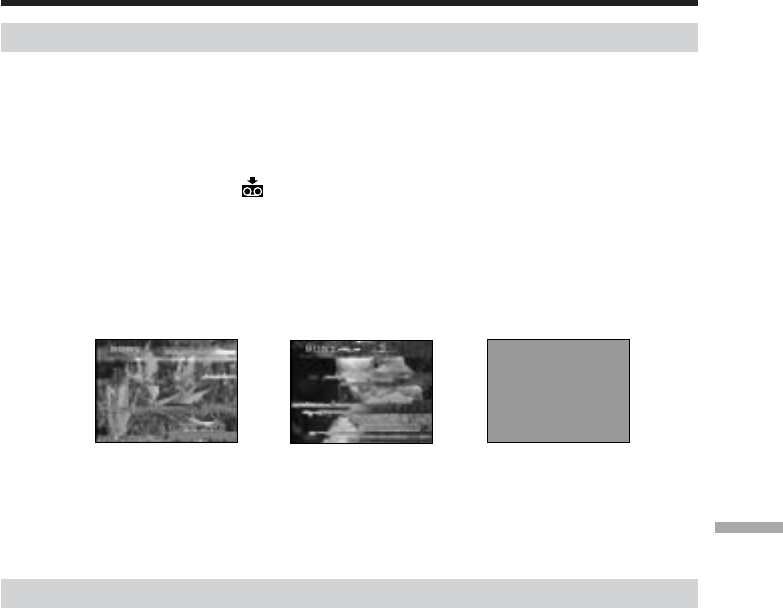
195
Additional Information
Maintenance information and precautions
[a] [b] [c]
Maintenance information
Cleaning the video head
To ensure normal recording and clear pictures, clean the video head. The video head
may be dirty when:
–mosaic-pattern noise appears on the playback picture.
–playback pictures do not move.
–playback pictures do not appear.
–the x indicator and “ CLEANING CASSETTE” message appear one after another
or the x indicator flashes on the screen during recording.
If the above problem, [a], [b] or [c] occurs, clean the video heads for 10 seconds with the
Sony MGRCLD-12CLD cleaning cassette (optional). Check the picture and if the above
problem persists, repeat cleaning.
If the video heads gets dirtier, the entire screen becomes blue [c].
Cleaning the LCD screen
If fingerprints or dust make the LCD screen dirty, we recommend using a LCD cleaning
cloth (supplied) to clean the LCD screen.
Charging the built-in rechargeable battery
Your camcorder is supplied with a built-in rechargeable battery installed so as to retain
the date and time, etc., regardless of the setting of the POWER switch. The built-in
rechargeable battery is always charged as long as you are using your camcorder. The
battery, however, will get discharged gradually if you do not use your camcorder. It
will be completely discharged in about three months if you do not use your camcorder
at all. Even if the built-in rechargeable battery is not charged, it will not affect the
camcorder operation. To retain the date and time, etc., charge the battery if the battery
is discharged.
Charging the built-in rechargeable battery
•Connect your camcorder to the house current using the AC adaptor supplied with
your camcorder, and leave your camcorder with the POWER switch turned off for
more than 24 hours.
•Or install the fully charged battery pack in your camcorder, and leave your camcorder
with the POWER switch turned off for more than 24 hours.
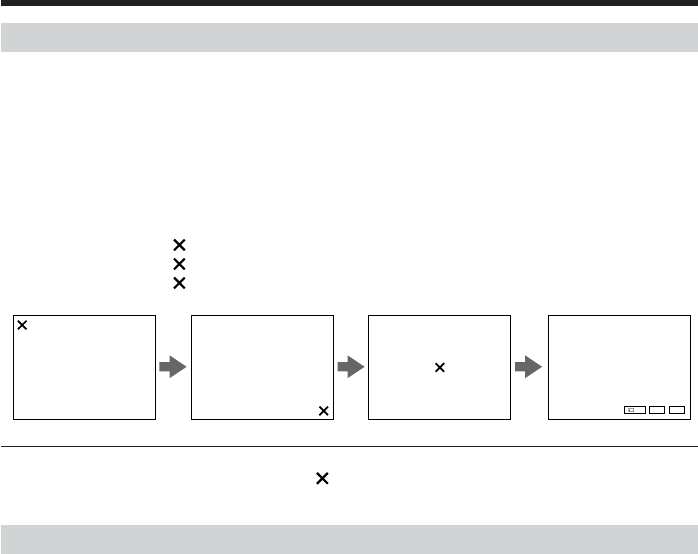
196
Maintenance information and precautions
CALIBRATE CALIBRATE CALIBRATE
FNINDEXPB
Ajusting the LCD screen (CALIBRATION)
The buttons on the touch panel may not work correctly. If this happens, follow the
procedure below.
(1)Set the POWER switch to OFF (CHG).
(2)Eject the tape from your camcorder, then disconnect any connecting cable from
your camcorder.
(3)Set the POWER switch to VCR while pressing DISPLAY/TOUCH PANEL on your
camcorder, then keep pressing DISPLAY/TOUCH PANEL for about five seconds.
(4)Follow the procedure below using the stylus supplied.
1Touch at the upper left corner.
2Touch at the lower right corner.
3Touch in the middle of the screen.
Note
If you do not press the right spot, always returns to the position at the upper left
corner. In this case, start from step 4 again.
Precautions
Camcorder operation
•Operate your camcorder on 7.2 V (battery pack) or 8.4 V (AC adaptor).
•For DC or AC operation, use the accessories recommended in this operating
instructions.
•If any solid object or liquid get inside the casing, unplug your camcorder and have it
checked by a Sony dealer before operating it any further.
•Avoid rough handling or mechanical shock. Be particularly careful of the lens.
•Keep the POWER switch set to OFF (CHG) when you are not using your camcorder.
•Do not wrap your camcorder with a towel, for example, and operate it. Doing so
might cause heat to build up inside.
•Keep your camcorder away from strong magnetic fields or mechanical vibration.
•Do not touch the LCD screen with a sharp object other than the stylus supplied. (DCR-
IP55 only)
•If your camcorder is used in a cold place, a residual image may appear on the LCD
screen. This is not a malfunction.
•While using your camcorder, the back of the LCD screen may heat up. This is not a
malfunction.
•Do not use the network function in a medical institution or in an aircraft (DCR-IP55
only).
On handling tapes
•Do not insert anything into the small holes on the rear of the cassette. These holes are
used to sense the type and thickness of the tape and if the recording tab is in or out.
•Do not open the tape protect cover or touch the tape.
•Avoid touching or damaging the terminals. To remove dust, clean the terminals with
a soft cloth.

197
Additional Information
Maintenance information and precautions
Camcorder care
•Remove the tape, and periodically turn on the power, operate the CAMERA and VCR
sections and play back a tape for about three minutes when your camcorder is not to
be used for a long time.
•Clean the lens with a soft brush to remove dust. If there are fingerprints on the lens,
remove them with a soft cloth.
•Clean the camcorder body with a dry soft cloth, or a soft cloth lightly moistened with
a mild detergent solution. Do not use any type of solvent which may damage the
finish.
•Do not let sand get into your camcorder. When you use your camcorder on a sandy
beach or in a dusty place, protect it from the sand or dust. Sand or dust may cause
your camcorder to malfunction, and sometimes this malfunction cannot be repaired.
AC power adaptor
•Unplug the unit from a wall outlet when you are not using the unit for a long time. To
disconnect the power cord, pull it out by the plug. Never pull the power cord itself.
•Do not operate the unit with a damaged cord or if the unit has been dropped or
damaged.
•Do not bend the power cord forcibly, or place a heavy object on it. This will damage
the cord and may cause fire or electrical shock.
•Prevent metallic objects from coming into contact with the metal parts of the
connecting section. If this happens, a short may occur and the unit may be damaged.
•Always keep metal contacts clean.
•Do not disassemble the unit.
•Do not apply mechanical shock or drop the unit.
•While the unit is in use, particularly during charging, keep it away from AM receivers
and video equipment. AM receivers and video equipment disturb AM reception and
video operation.
•The unit becomes warm during use. This is not a malfunction.
•Do not place the unit in locations that are:
– Extremely hot or cold
– Dusty or dirty
– Very humid
– Vibrating
About care and storage of the lens
•Wipe the surface of the lens clean with a soft cloth in the following instance:
–When there are fingerprints on the lens surface
–In hot or humid locations
–When the lens is used in environments such as the seaside
•Store the lens in a well-ventilated location subject to little dirt or dust.
To prevent mold from occuring, periodically perform the above.
We recommend turning on and operating the video camera recorder about once per
month to keep the video camera recorder in an optimum state for a long time.

198
Maintenance information and precautions
Battery pack
•Use only the specified charger or video equipment with the charging function.
•To prevent an accident from a short circuit, do not allow metal objects to come into
contact with the battery terminals.
•Keep the battery pack away from fire.
•Never expose the battery pack to temperatures above 60 °C (140 °F), such as in a car
parked in the sun or under direct sunlight.
•Store the battery pack in a cool, dry place.
•Do not expose the battery pack to any mechanical shock.
•Do not disassemble nor modify the battery pack.
•Attach the battery pack to the video equipment securely.
•Charging while some capacity remains does not affect the original battery capacity.
Notes on dry batteries
To avoid possible damage from battery leakage or corrosion, observe the following:
•Be sure to insert the batteries with the + – polarities matched to the + – marks.
•Dry batteries are not rechargeable.
•Do not use a combination of new and old batteries.
•Do not use different types of batteries.
•Current flows from batteries when you are not using them for a long time.
•Do not use leaking batteries.
If batteries are leaking
•Wipe off the liquid in the battery compartment carefully before replacing the batteries.
•If you touch the liquid, wash it off with water.
•If the liquid get into your eyes, wash your eyes with a lot of water and then consult a
doctor.
If any problem occurs, unplug your camcorder and contact your nearest Sony dealer.

199
Additional Information
Specifications
Video camera
recorder
System
Video recording system
2 rotary heads
Helical scanning system
Audio recording system
2 rotary heads, PCM system
Quantization: 12 bits (Fs 32 kHz,
stereo 1, stereo 2)
Video signal
NTSC color, EIA standards
Usable cassette
MICROMV cassette with the
mark printed
Tape speed
Approx. xxx mm/s
Recording/playback time
(using cassette MGR60)
xxx hour
Fastforward/rewind time
(using cassette MGR60)
Approx. one min. and 30 seconds
Viewfinder
Electric viewfinder (color)
Image device
3.8 mm (1/4.7 type) CCD
(Charge Coupled Device)
Approx. 1 000 000 pixels
(Effective: 690 000 pixels)
Lens
Carl Zeiss
Combined power zoom lens
Filter diameter xx mm. (1 3/16 in.)
10× (Optical), 120× (Digital)
Focal length
3.7 - 37 mm (5/32 - 1 1/2 in.)
When converted to a 35 mm still
camera
CAMERA:
50 - 500 mm (xxx - xxxx in.)
MEMORY:
42 - 420 mm (xxx - xxxx in.)
Color temperature
Auto, HOLD (Hold), nIndoor
(3 200K), Outdoor (5 800K)
Minimum illumination
15 lx (lux) (F 1.8)
0 lx (lux) (in the NightShot mode)*
*Objects unable to be seen due to
the dark can be shot with
infrared lighting.
Input/Output connectors
Audio/Video input/output
10-pin connector
Input/output auto switch
Video signal: 1 Vp-p, 75 Ω (ohms),
unbalanced, sync negative
Luminance signal: 1 Vp-p, 75 Ω
(ohms), unbalanced
Chrominance signal: 0.286 Vp-p,
75 Ω (ohms), unbalanced
Audio signal: 327 mV, (at output
impedance more than 47 kΩ
(kilohms) )
Input impedance with more than
47 kΩ (kilohms)
Output impedance with less than
2.2 kΩ (kilohms)
i. LINK (MICROMV) input/output
4-pin connector S400
LANC jack
Stereo mini-minijack (ø 2.5 mm)
USB jack
mini-B
LCD screen
Picture
6.2 cm (2.5 type)
xx × xx mm (xx × xxx in.)
Total dot number:
xxx xxx (xxx × xxx)
Wireless communication
(DCR-IP55 only)
Communication system
Bluetooth specification Ver. 1.1
Maximum communication
speed 1) 2)
Approx. 723 kbps
Maximum output
Bluetooth specification Power
Class2
Communication distance 2)
Approx. 10 m (33 feet) (Open
space, when using a Sony BTA-
NW1 Modem Adaptor with
Bluetooth Function)
Compatible Bluetooth profiles 3)
Generic Access Profile
Dial-up Networking Profile
Usable frequency band
2.4 GHz band
(2.400 – 2.4835 GHz)
1) The maximum rate defined by
Bluetooth specification Ver. 1.1
2) Depends on obstacles between
the Bluetooth devices, radio
wave conditions, etc.
3) Defined by Bluetooth
specification for intended use
between the Bluetooth devices
General
Power requirements
xxx V (battery pack)
xxx V (AC power adaptor)
Average power consumption
(when using the battery pack)
During camera recording using
LCD: xxx W
Viewfinder: xxx W
Operating temperature
0 °C to 40 °C (32 °F to 104 °F)
Storage temperature
–20 °C to +60 °C (–4 °F to +140 °F)
Dimensions (approx.)
xx × xxx × xx mm
(2 3/8 × 4 1/8 × 3 7/8 in.) (w/h/d)
Mass (approx.)
xxx g (xx lb xx oz)
excluding the battery pack and
cassette
xxx g (x lb xx oz)
including the battery pack,
NP-FF50, cassette MGR60 and lens
cap
Supplied accessories
See page xx.
AC power adaptor
Power requirements
100 - 240 V AC, 50/60 Hz
Power consumption
23 W
Output voltage
DC OUT: 8.4 V, 1.5 A in the
operating mode
Operating temperature
0 °C to 40 °C (32 °F to 104 °F)
Storage temperature
–20 °C to +60 °C (–4 °F to +140 °F)
Dimensions (approx.)
125 × 39 × 62 mm (5 × 1 9/16 ×2 1/
2 in.) (w/h/d) excluding
projecting parts
Mass (approx.)
280 g (9.8 oz)
excluding power cord

200
Battery pack
Maximum output voltage
DC 8.4 V
Output voltage
DC 7.2 V
Capacity
48 Wh (675 mAh)
Operating temperature
0°C to 40°C (32°F to 104°F)
Dimensions (approx.)
40.8 × 12.5 × 49.1 mm
(1 5/8 × 1/2 × 1 15/16 in.)
(w/h/d)
Mass (approx.)
45 g (1.6 oz)
Type
Lithium ion
“Memory Stick”
Memory
Flash memory
8MB: MSA-8A
Operating voltage
2.7-3.6V
Power consumption
Approx. 45mA in the operating
mode
Approx. 130µA in the standby
mode
Dimensions (approx.)
50 × 2.8 × 21.5 mm
(2 × 1/8 × 7/8 in.) (w/h/d)
Mass (approx.)
4 g (0.14 oz)
Design and specifications are
subject to change without notice.
Specifications
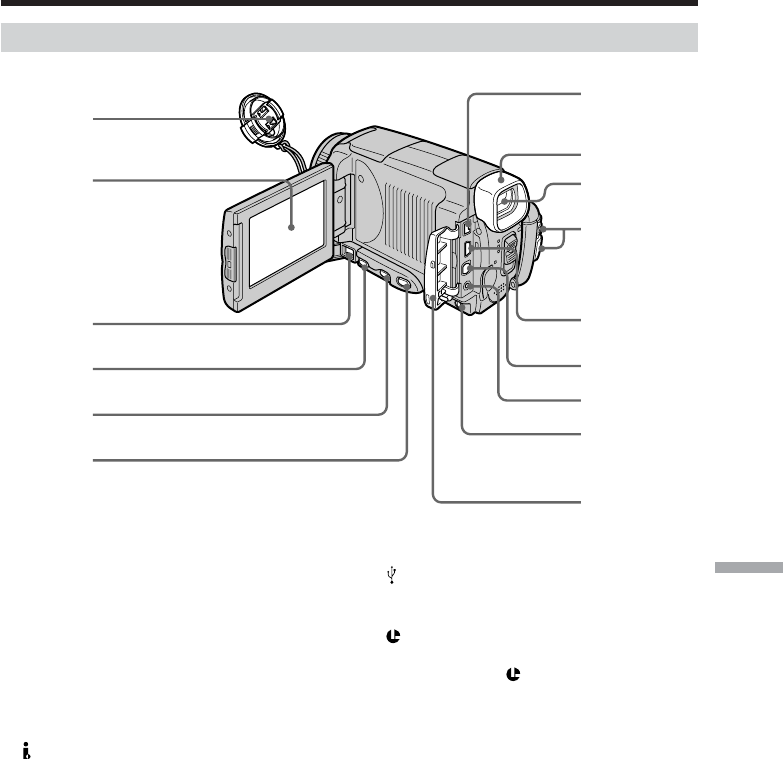
201
Quick Reference
1
2
7
8
9
q;
qa
qs
qd
qf
qg
3
4
5
6
— Quick Reference —
Identifying the parts and controls
1Lens cap (p. xx)
2LCD screen/Touch panel (p. xx, xx)
3DC IN jack
4FOCUS button (p. xx)
5BACK LIGHT button (p. xx)
6DISPLAY/TOUCH PANEL button (p. xx)
7 i.LINK (MICROMV) jack (p. xx)
The i.LINK (MICROMV) jack is i.LINK
compatible.
8Eyecup
9Viewfinder (p. xx)
q; > and BATT (battery) RELEASE levers
(p. xx)
Camcorder
qa (USB) jack (p. xx)
qs A/V (ID-2) jack (p. xx)
qd (LANC) jack (p. xx)
LANC stands for Local Application Control
Bus System. The control jack is used for
controlling the tape transport of video
equipment and other peripherals connected
to the video equipment. This jack has the
same function as the jack indicated as
CONTROL L or REMOTE.
qf LCD BACKLIGHT switch (p.xx)
qg Jack cover (p. xx)
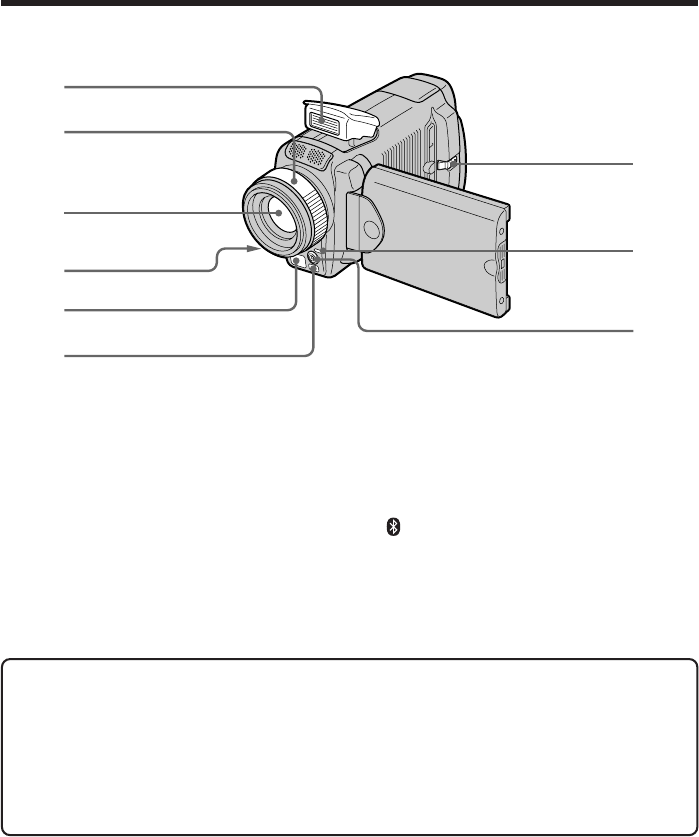
202
qh Flash
qj Focus ring (p. xx)
qk Lens
ql Camera recording lamp (p. xx)
w; Infrared rays emitter (p. xx)
Identifying the parts and controls
qh
qj
qk
ql
w;
wa
ws
wd
wf
wa Remote sensor
ws OPEN button (p. xx)
wd (Bluetooth) lamp (DCR-IP55 only) (p.xx)
wf HOLOGRAM AF emitter (p.xx)
Note on the Carl Zeiss lens
Your camcorder is equipped with a Carl Zeiss lens which can reproduce a fine image.
The lens for your camcorder was developed jointly by Carl Zeiss, in Germany, and Sony
Corporation. It adopts the MTF* measurement system for video camera and offers a quality as
the Carl Zeiss lens.
*MTF is an abbreviation of Modulation Transfer Function.
The value number indicates the amount of light of a subject penetrating into the lens.
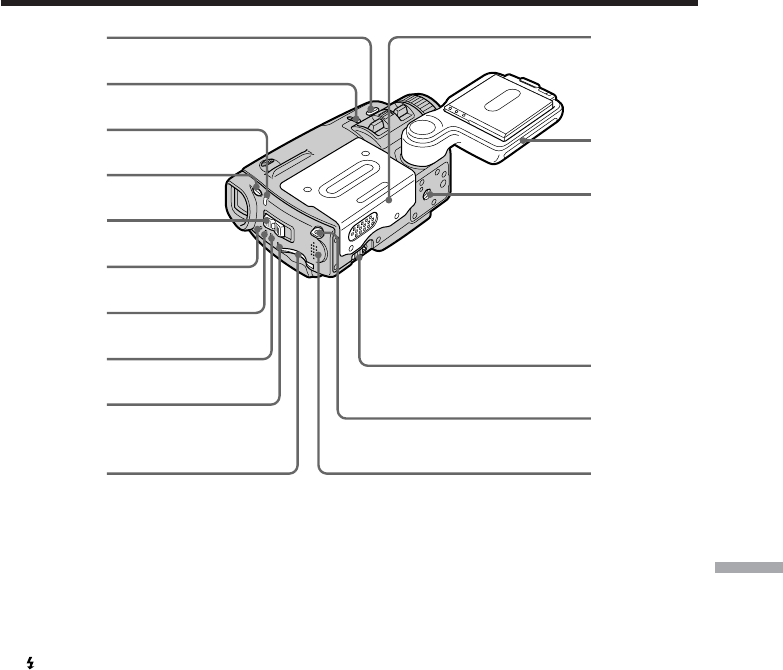
203
Quick Reference
Identifying the parts and controls
wg eg
eh
ej
ek
el
r;
wh
wj
wk
wl
e;
ea
es
ed
ef
wg COLOR SLOW S/SUPER NIGHTSHOT
button (p.xx)
wh NIGHTSHOT switch (p. xx)
wj Charge lamp (p. xx)
wk (flash) button (p.xx)
wl POWER switch (p. xx)
e; CAMERA lamp (p.xx)
ea MEMORY/NETWORK lamp (DCR-IP55) or
MEMORY lamp (DCR-IP45) (p.xx)
es VCR lamp (p.xx)
ed “Memory Stick” access lamp (p. xx)
ef “Memory Stick” slot (p. xxx)
eg Cassette lid (p. xx)
eh Grip (p.xx)
ej Tripod receptacle
Make sure that the length of the tripod
screw is less than 5.5 mm (7/32 inch).
Otherwise, you cannot attach the tripod
securely and the screw may damage your
camcorder.
ek OPEN/ZEJECT lever (p. xx)
el Hook for wrist strap (p.xx)
r; Speaker
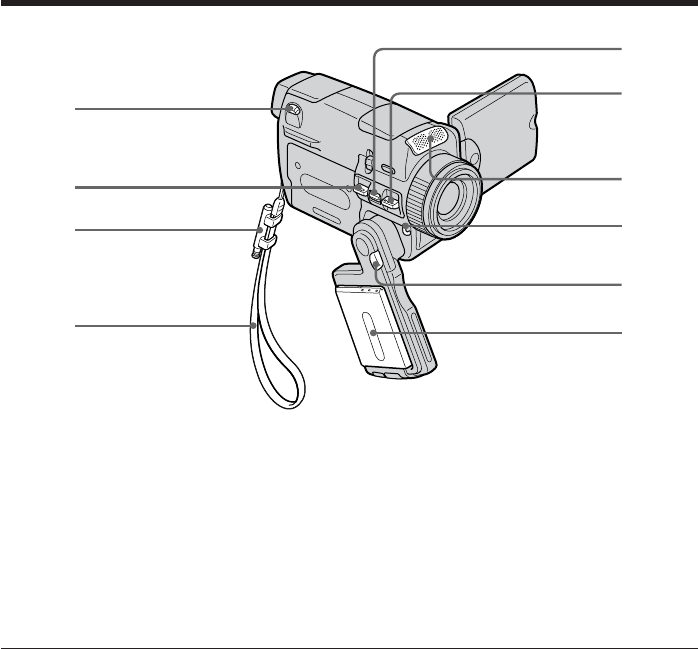
204
Identifying the parts and controls
ra
rg
rh
rj
rk
rl
t;
rs
rd
rf
ra Viewfinder lens adjustment lever (p. xx)
rs PHOTO button (p. xx, xx)
rd Stylus holder (p.xx)
rf Wrist strap (p.xx)
rg Power zoom lever (p. xx)
rh START/STOP button (p. xx)
rj Microphone
rk Hook for lens cap (p.xx)
rl PUSH button (p.xx)
t; Battery pack or battery terminal cover
(p. xx)
How to attach the supplied wrist strap
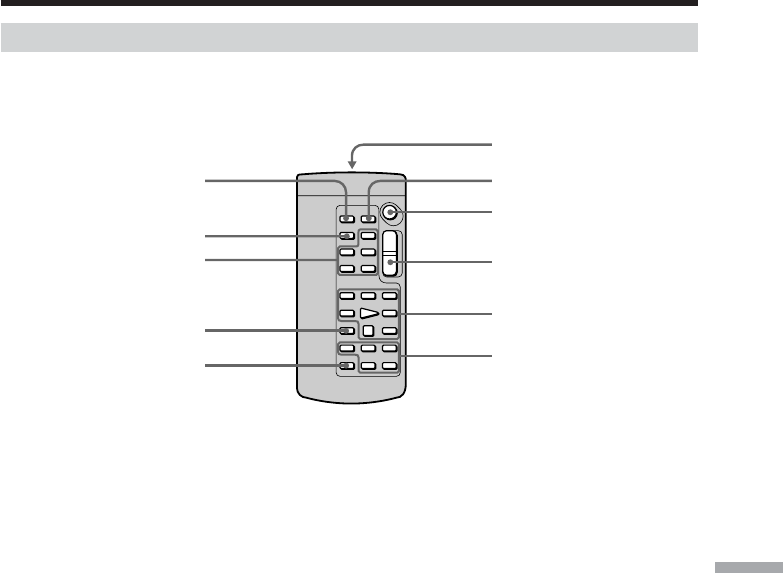
205
Quick Reference
Identifying the parts and controls
Remote Commander
The buttons that have the same name on the Remote Commander as on your camcorder
function identically to the buttons on your camcorder.
qa
4
3
2
1
9
q;
8
7
6
5
1PHOTO button (p. XX, XX)
2DISPLAY button (p. XX)
3MEMORY control buttons
4SEARCH MODE button (p. XX to XX)
5MULTI SRCH button (p. XX)
6Transmitter
Point toward the remote sensor to control
your camcorder after turning on your
camcorder.
7DATA CODE button (p. XX)
8START/STOP button (p. XX)
9Power zoom button (p. XX)
0Video control buttons (p. XX)
qa X/x/C/c/EXECUTE buttons
These buttons function the same as the
control button on the camcorder.
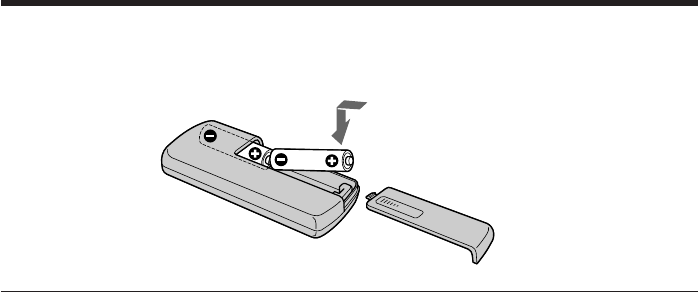
206
To prepare the Remote Commander
Insert 2 R6 (size AA) batteries by matching the + and – polarities on the batteries to the
+ – marks inside the battery compartment.
Notes on the Remote Commander
•Point the remote sensor away from strong light sources such as direct sunlight or
overhead lighting. Otherwise, the Remote Commander may not function properly.
•Your camcorder works in the commander mode VTR 2. Commander modes 1, 2 and 3
are used to distinguish your camcorder from other Sony VCRs to avoid remote control
misoperation. If you use another Sony VCR in the Commander mode VTR 2, we
recommend changing the commander mode or covering the sensor of the VCR with
black paper.
Identifying the parts and controls
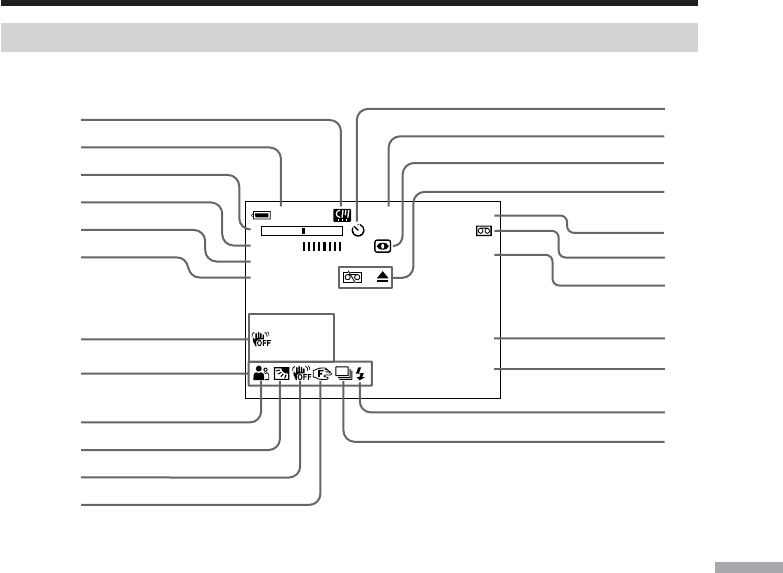
207
Quick Reference
120min STBY 0:12:34
—+ 12min
ST I LL END
16:9WIDE SEARCH
NEG . ART
AUT
50 AWB MPEG IN
F11 9db
100—0001
6
5
4
3
2
1
9
0
qa
qs
w;
ql
qk
qh
7
8
qf
qg
qd
qj
wa
wd
ws
Operation indicators
1Micro cassette memory (p. xx)
2Remaining battery time (p. xx)
3Zoom (p. xx)/Exposure (p. xx)/Data file
name (p. xx)
4Digital effect (p. xx)/MEMORY MIX
(p. xxx)/FADER (p. xx)
516:9WIDE (p. xx)
6Picture effect (p. xx)
7Data code (p. xx)
8Date
9PROGRAM AE (p. xx)
0Backlight (p. xx)
qa SteadyShot off (p. xxx)
qs Manual focus (p. xx)
qd Self-timer (p. xx, xxx)
qf STBY/REC (p. xx)/Video control mode (p.
xx)/Picture size (p. xxx)/Image quality
mode (p. xxx)
LCD screen and viewfinder
Identifying the parts and controls
qg NIGHTSHOT/SUPER NIGHTSHOT (p.xx)/
COLOR SLOW SHUTTER (p.xx)
qh Warning (p. xxx)
qj Tape counter (p. xx)/Time code (p.xx)/
Self-diagnosis (p. xx)/Photo mode (p. xx,
xxx)/Image number (p. xxx)
qk Remaining tape (p. xx)/Memory playback
(p. xxx)
ql END SEARCH (p. xx)
w; MPEG IN (p. xxx)
wa Data file name (p. xxx)
This indicator appears when the MEMORY
MIX functions work. /Time
ws Video flash ready
This indicator appears when you use the
video flash light (optional).
wd NORMAL screen mode (p. xxx)
This indicator appears when you record
still images continuously.

208
Index
A, B
AC power adaptor .................. xx
Adjusting viewfinder ............. xx
Audio dubbing ........................ xx
Auto red-eye reduction .......... xx
AUTO SHTR ............................ xx
A/V connecting cable ............ xx
BACK LIGHT .......................... xx
Battery pack ............................. xx
BEEP ......................................... xx
BOUNCE .................................. xx
C, D
CALIBRATION ....................... xx
Camera chromakey ................ xx
Carl Zeiss lens ......................... xx
Cassette information .............. xx
Cassette memory .................... xx
Charging battery ..................... xx
Charging built-in rechargeable
battery ................................... xx
Cleaning cassette
Clock set ................................... xx
COLOR SLOW SHUTTER .... xx
Continuous photo recording . xx
Data code ................................. xx
Date search .............................. xx
DEMO MODE ......................... xx
DIGITAL EFFECT .................. xx
DISPLAY .................................. xx
Dubbing a tape ........................ xx
E
END SEARCH ................... xx, xx
EXP BRKTG ........................... xxx
Exposure .................................. xx
F, G, H
Fader ......................................... xx
Fade in/out .............................. xx
Flash .......................................... xx
FLASH MOTION .................... xx
Flexible Spot Meter ................. xx
FOCUS ...................................... xx
Format ...................................... xx
Full charge ............................... xx
Grip ........................................... xx
Heads ........................................ xx
HOLOGRAM AF ................... XX
I, J, K, L
i.LINK ....................................... xx
Image protection ..................... xx
Image quality mode ............... xx
Image size .............................. xxx
Index screen ............................. xx
“InfoLITHIUM” battery ........ xx
Infrared rays emitter .............. xx
JPEG .......................................... xx
Labelling a cassette ................. xx
(LANC) jack ........................ xx
LUMINANCEKEY ................. xx
M, N
Manual focus ........................... xx
Memory chromakey ............... xx
Memory luminancekey .......... xx
MEMORY MIX ........................ xx
Memory overlap ..................... xx
Memory PB ZOOM ................ xx
Memory photo recording ...... xx
“Memory Stick” ...................... xx
Menu settings .......................... xx
Micro cassette memory
Mirror mode ............................ xx
Moisture condensation .......... xx
MONOTONE .......................... xx
MOSC. FADER ........................ xx
MPEG ....................................... xx
Multi-picture search ............... xx
Multi screen mode .................. xx
NETWORK ............................. XX
NIGHTSHOT .......................... xx
NORM. FADER ...................... xx
NTSC system ........................... xx
O, P, Q
OLD MOVIE ............................ xx
Operation indicators .............. xx
PAL system .............................. xx
PB ZOOM ................................ xx
PICTURE EFFECT .................. xx
Playback pause ........................ xx
Playback time .......................... xx
Power zoom ............................. xx
Print mark ................................ xx
PROGRAM AE ....................... xx
R
Recording time ........................ xx
Remaining battery time
indicator ................................ xx
Remaining tape indicator ...... xx
Remote commander ............... xx
Remote sensor ......................... xx
Reset ......................................... xx
S
Self-diagnosis display ............ xx
Self-timer recording ............... xx
Slide show ................................ xx
SPOT FOCUS .......................... xx
STEADYSHOT ........................ xx
STILL ........................................ xx
Stylus ....................................... XX
SUPER NIGHTSHOT ............. xx
S VIDEO jack ........................... xx
T, U, V
Tape counter ............................ xx
Tape PB ZOOM ....................... xx
Telephoto ................................. xx
Time code ................................. xx
Title ........................................... xx
Title search ............................... xx
Touch panel ............................. xx
TRAIL ....................................... xx
Transition ................................. xx
TV color systems ..................... xx
USB jack ................................... xx
USB streaming ......................... xx
W, X, Y, Z
Warning indicators ................. xx
White balance .......................... xx
Wide-angle .............................. xx
Wide mode .............................. xx
WORLD TIME ......................... xx
Wrist strap ............................... xx
Write-protect tab ..................... xx
Zoom ........................................ xx

Sony Corporation Printed in Japan *307461611*
Printed using vegitable oil ink with less than
1% VOC (Volatile Organic Compound).